SpringBoot的web开发
静态资源映射规则

总结:只要静态资源放在类路径下:
called /static (or /public or /resources or //METAINF/resources
一启动服务器就能访问到静态资源文件
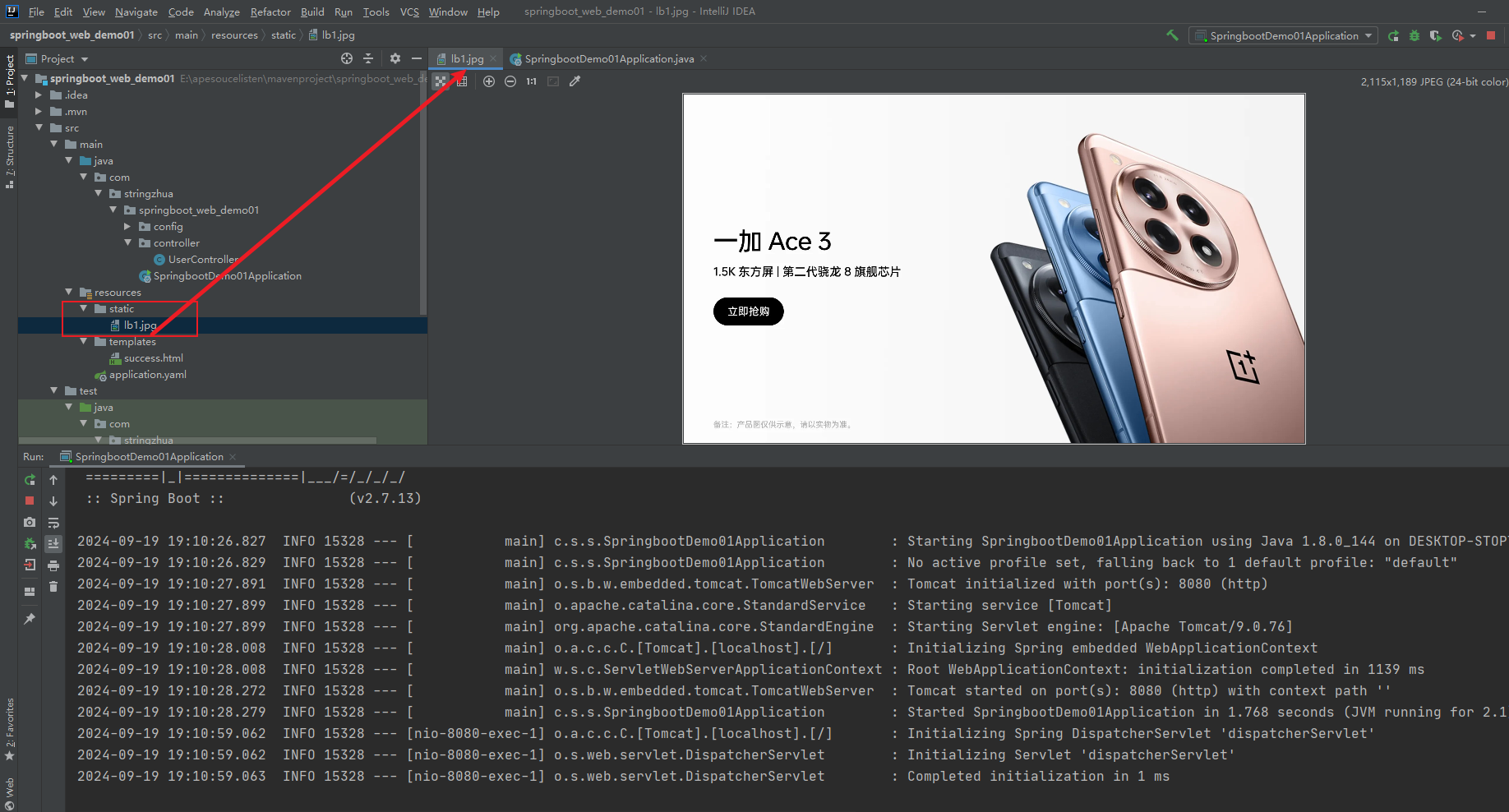
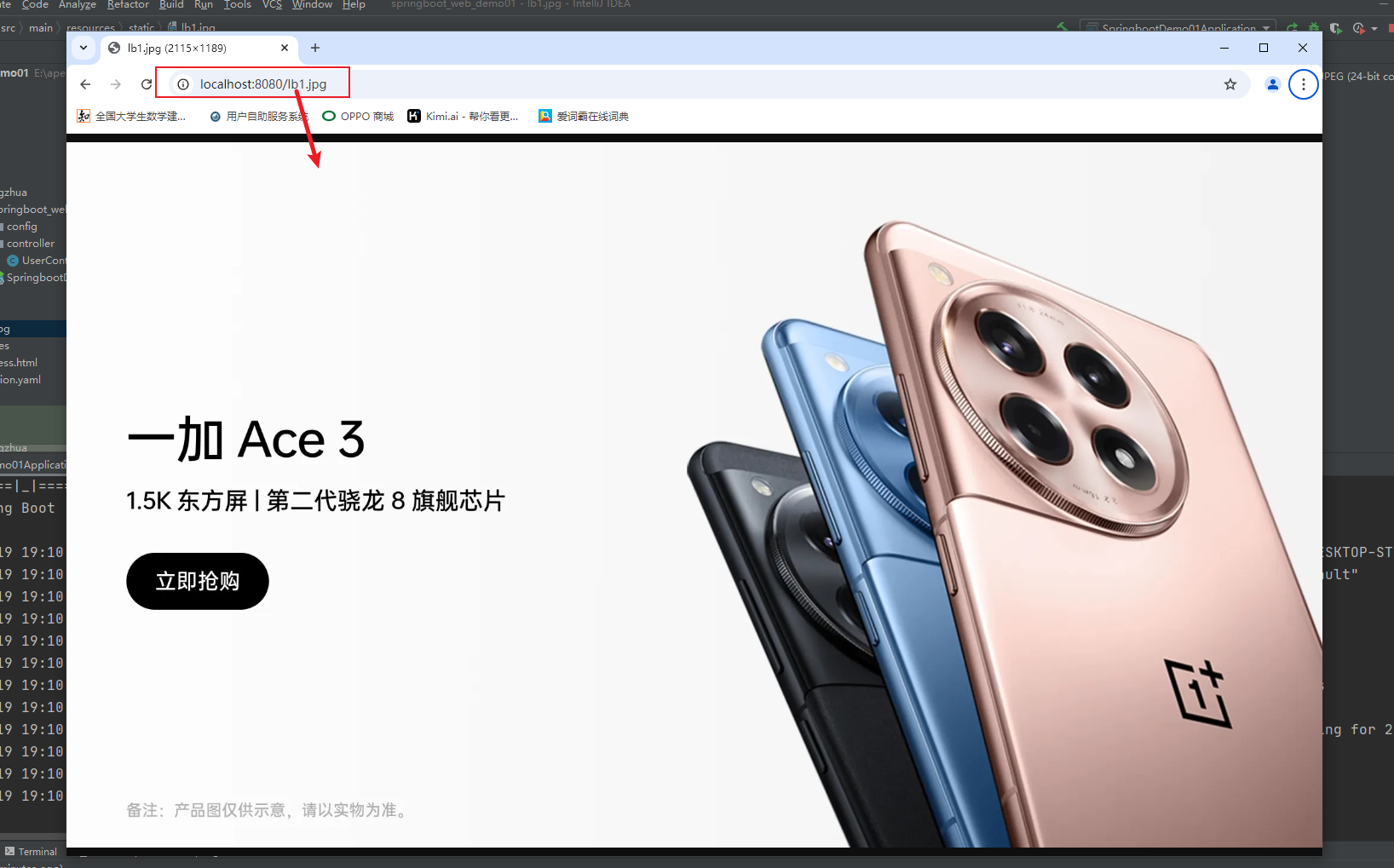
springboot只需要将图片放在 static 下 就可以被访问到了
总结:
只要静态资源放在类路径下: called /static (or INF/resources
访问:当前项目根路径/ + 静态资源名
静态资源访问前缀
spring:
mvc:
static-path-pattern: static/test/**
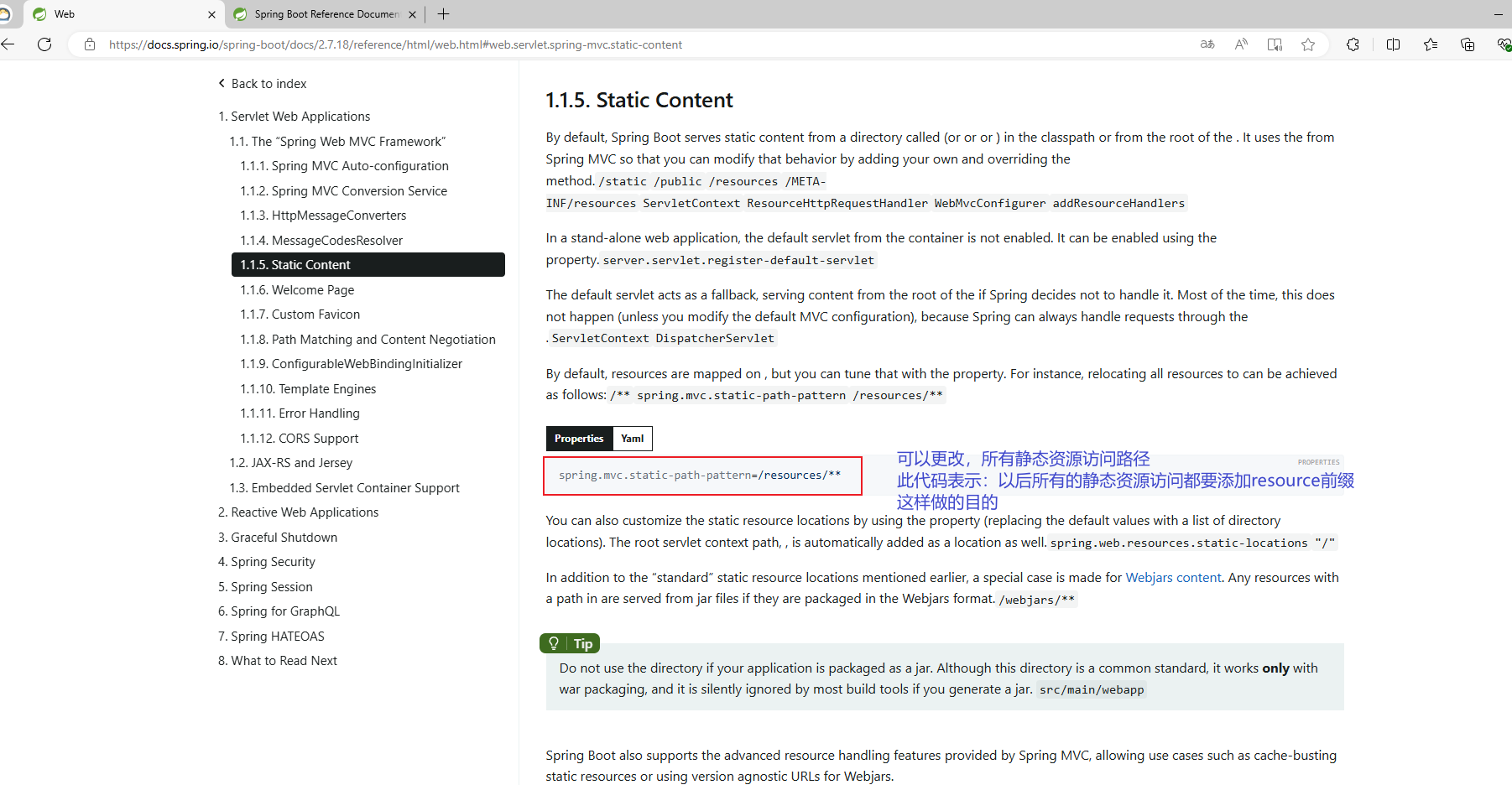
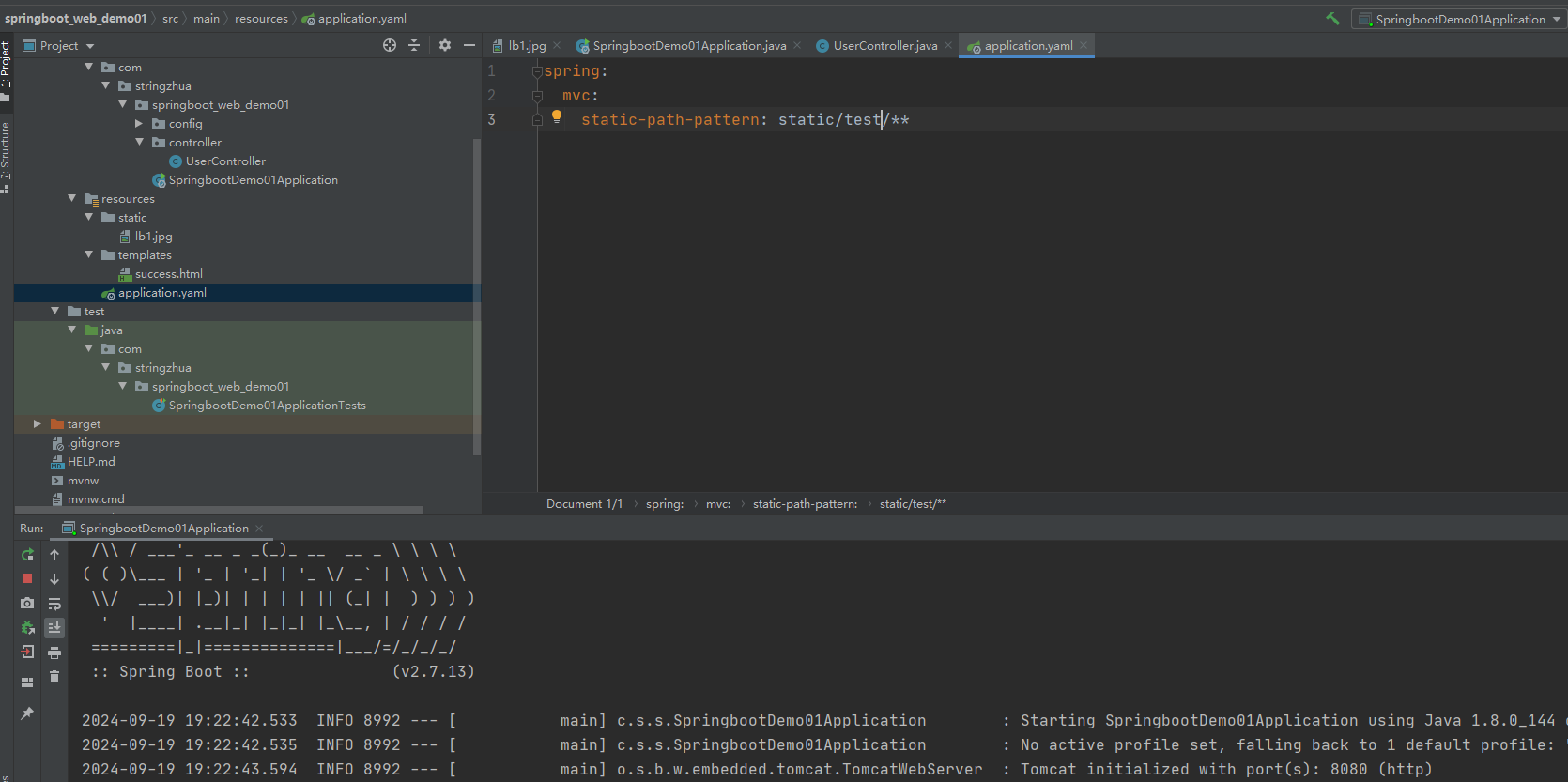
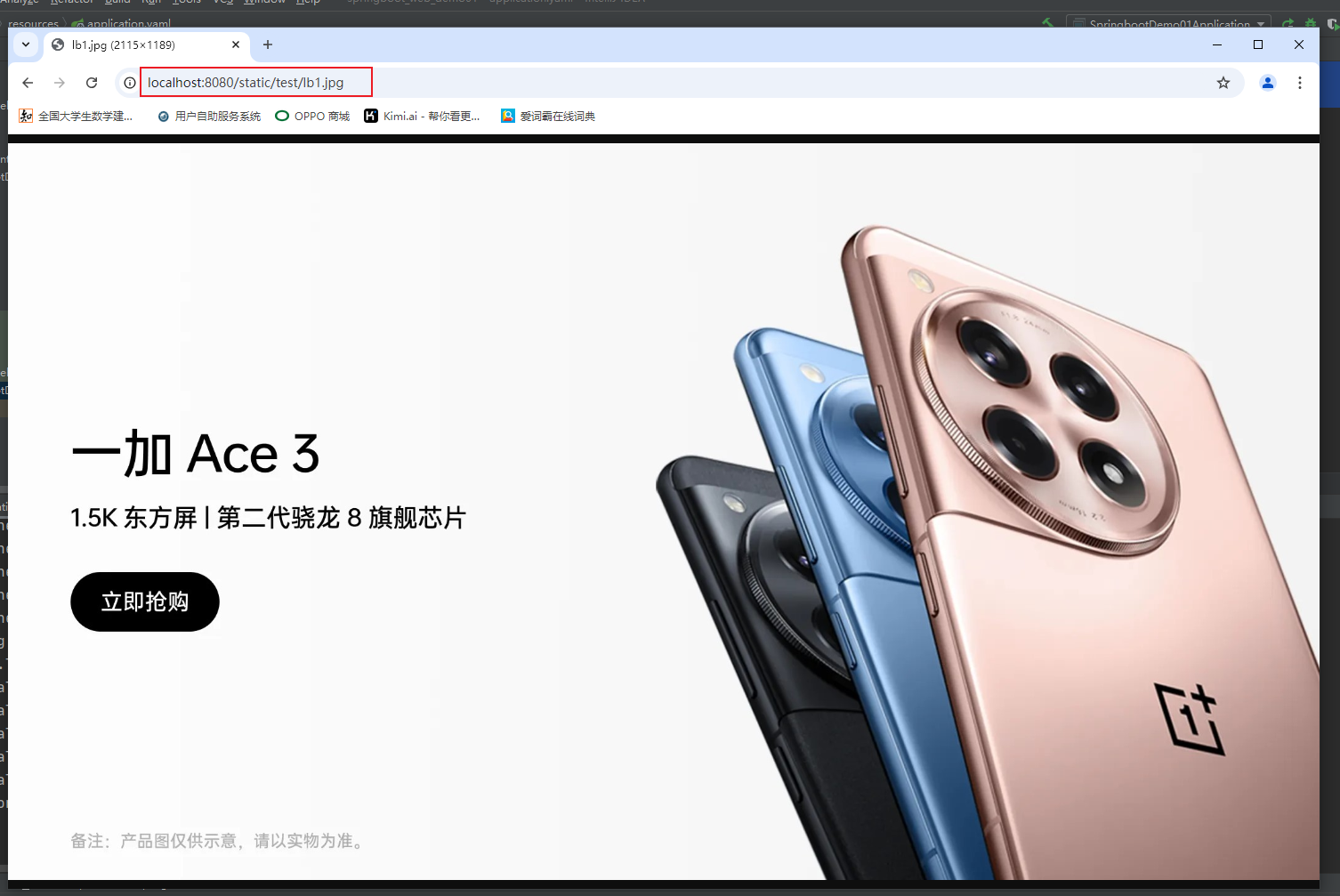
enjoy模板引擎
四个步骤:
1.加坐标
<dependency>
<groupId>com.jfinal</groupId>
<artifactId>enjoy</artifactId>
<version>5.0.3</version>
</dependency>
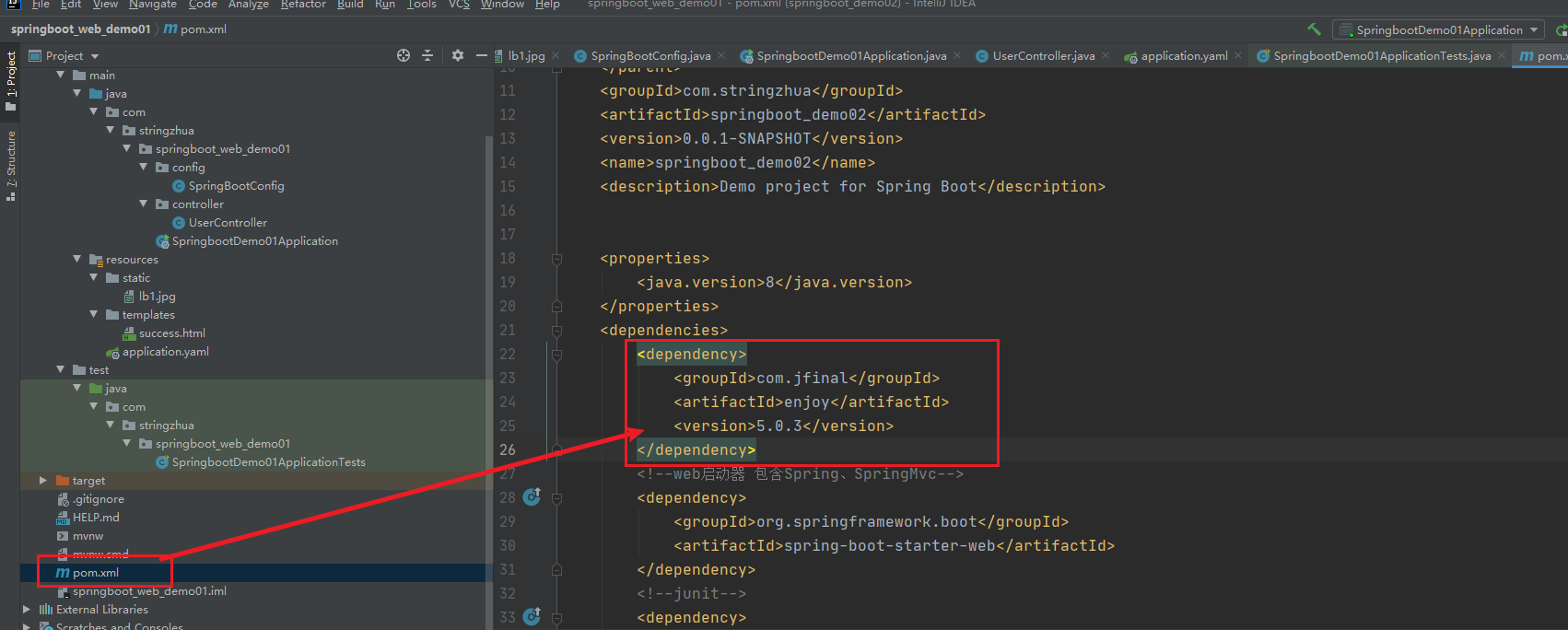
2.开启配置
在configure包下新建配置类 官网可以复制https://gitee.com/jfinal/enjoy
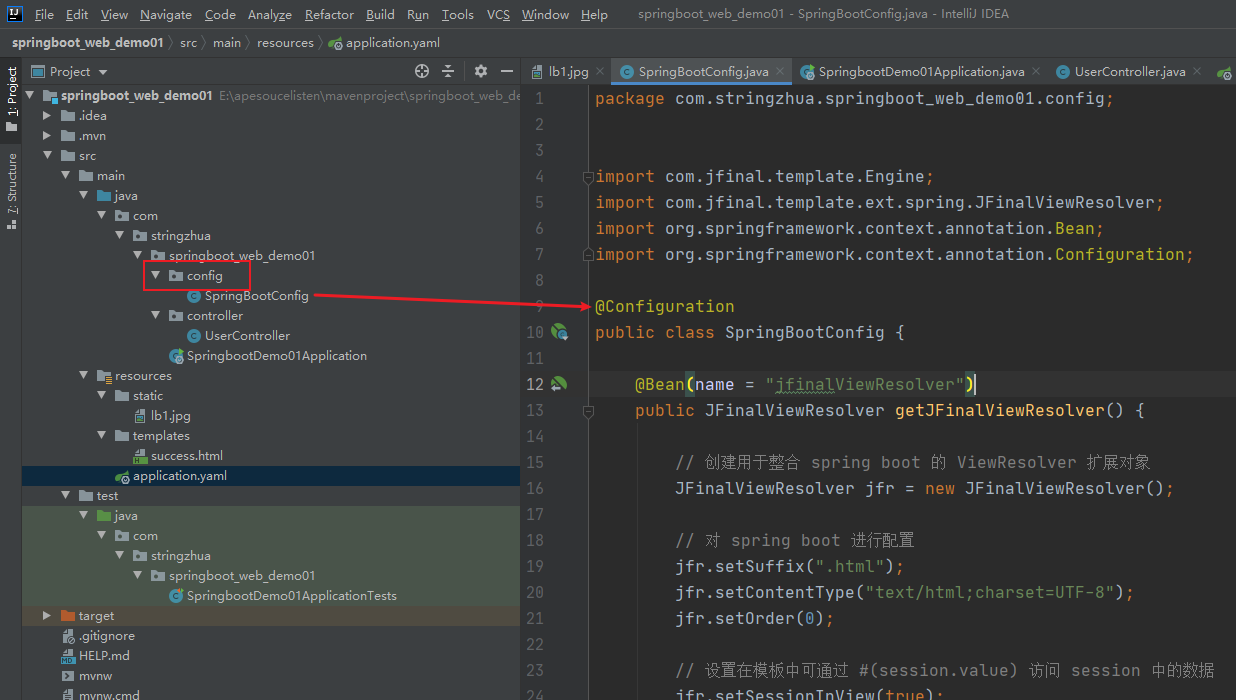
package com.stringzhua.springboot_web_demo01.config;
import com.jfinal.template.Engine;
import com.jfinal.template.ext.spring.JFinalViewResolver;
import org.springframework.context.annotation.Bean;
import org.springframework.context.annotation.Configuration;
@Configuration
public class SpringBootConfig {
@Bean(name = "jfinalViewResolver")
public JFinalViewResolver getJFinalViewResolver() {
// 创建用于整合 spring boot 的 ViewResolver 扩展对象
JFinalViewResolver jfr = new JFinalViewResolver();
// 对 spring boot 进行配置
jfr.setSuffix(".html");
jfr.setContentType("text/html;charset=UTF-8");
jfr.setOrder(0);
// 设置在模板中可通过 #(session.value) 访问 session 中的数据
jfr.setSessionInView(true);
// 获取 engine 对象,对 enjoy 模板引擎进行配置,配置方式与前面章节完全一样
Engine engine = JFinalViewResolver.engine;
// 热加载配置能对后续配置产生影响,需要放在最前面
engine.setDevMode(true);
// 使用 ClassPathSourceFactory 从 class path 与 jar 包中加载模板文件
engine.setToClassPathSourceFactory();
// 在使用 ClassPathSourceFactory 时要使用 setBaseTemplatePath
// 代替 jfr.setPrefix("/view/")
engine.setBaseTemplatePath("/templates/");
// 更多配置与前面章节完全一样
// engine.addDirective(...)
// engine.addSharedMethod(...);
return jfr;
}
}
3.将页面保存在templates目录下
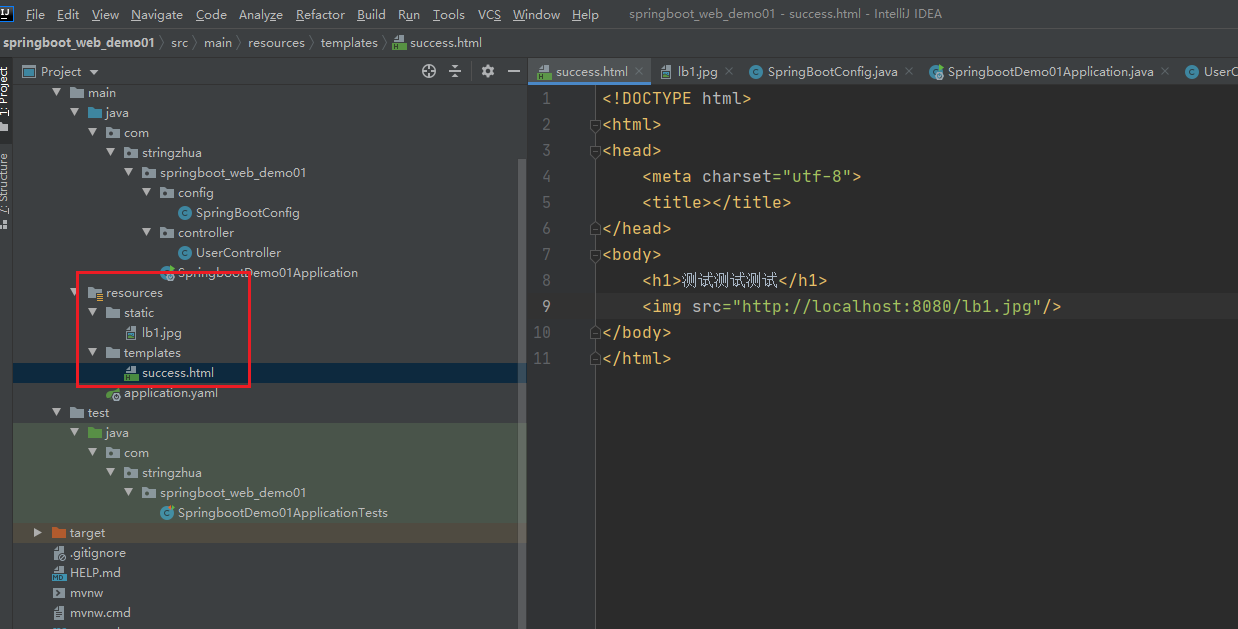
<!DOCTYPE html>
<html>
<head>
<meta charset="utf-8">
<title></title>
</head>
<body>
<h1>测试测试测试</h1>
<img src="http://localhost:8080/lb1.jpg"/>
</body>
</html>
4.编写代码逻辑
package com.stringzhua.springboot_web_demo01.controller;
import org.springframework.stereotype.Controller;
import org.springframework.web.bind.annotation.*;
/**
* @Author Stringzhua
* @Date 2024/9/18 12:05
* description:
*/
@Controller
@RequestMapping("/user")//一级目录
public class UserController {
/**
* @RequestMapping 意义:处理用户的请求,相似于doget与dopost
* 位置:
* 类上:一级目录
* 方法:二级目录
* 例如:user/save
* user/delete
* student/save
* student/delete
* 属性:
* value = "",path = "" value等同于path,只有它时可省略
* 表示请求路径
* =========================
* method=常量,此请求的类型(get,post),若不设置则此请求适配所有的请求方式
* =========================
* params = ""
* 限制请求参数,例如:params={"msg1","msg2"}表示请求路径中必须携带参数名为msg1与msg2的参数
* 注意:1.超链接默认发送的是get请求
* 2.所有请求所携带的参数格式均为:key = value
* @DeleteMapping 删除
* @PutMapping 修改
* @GetMapping 查询
* @PostMapping 新增
* @RequestMapping 可以点击查看源码
* @Target({ElementType.METHOD,ElementType.TYPE}) METHOD==代表修饰方法,TYPE==代表修饰类
*/
@RequestMapping(value = "/init")//二级目录
public String init() {
System.out.println("==========进入了springMVC的控制器=========");
System.out.println("返回业务层,调用持久层");
return "success";//返回方法执行完要跳转的页面名称
}
}
加坐标 写配置类
在templates 下有success.html
不加 responsebody
测试:
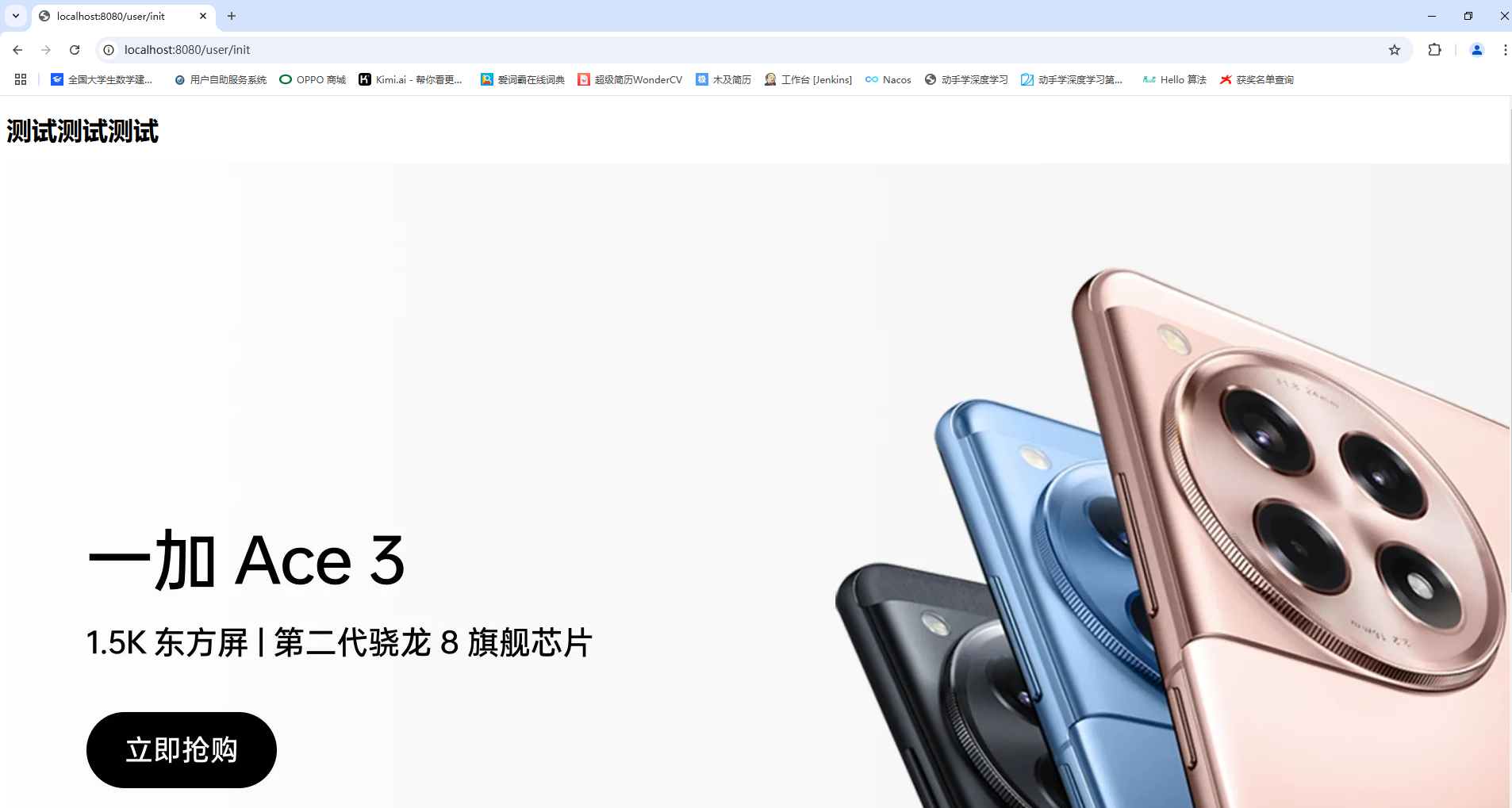
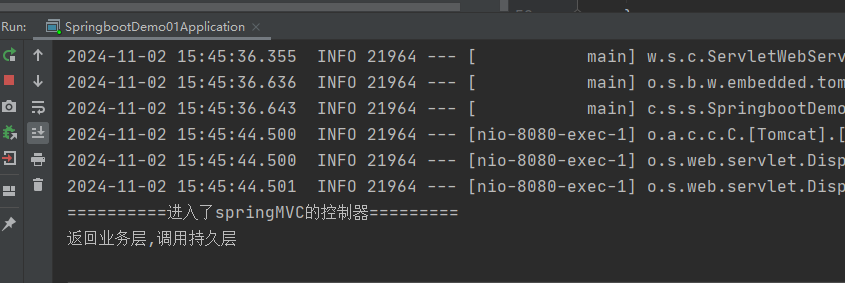
SpringMVC
1.请求处理
2.参数绑定
3.常用注解
4.数据传递
5.文件上传
SpringMVC-请求处理
@RequestMapping
- 意义:处理用户的请求,相似于doget与dopost
- 位置:
- 类上:一级目录
- 方法:二级目录
例如:
- user/save
- user/delete
- student/save
- student/delete
属性:
- value = “”,path = “” 表示请求路径
- method=常量,此请求的类型(get,post),若不设置则此请求适配所有的请求方式
- params = ""限制请求参数,
- 例如:params={“msg1”,“msg2”}表示请求路径中必须携带参数名为msg1与msg2的参数
注意:
- 超链接默认发送的是get请求
- 所有请求所携带的参数格式均为:key = value
还有这些请求
- @GetMapping 查询
- @PostMapping 新增
- @PutMapping 修改
- @DeleteMapping 删除
@RequestMapping可以点击查看源码
@Target({ElementType.METHOD, ElementType.TYPE})
METHOD代表修饰方法,TYPE代表修饰类
浏览器默认 get请求
post 跳转不了
测试:
demo01.postman_collection.json
准备工作:下载postman
官网:https://www.postman.com/
1.下载postman使用postman测试
2.新建文件夹,新建测试:使用上面的success.html作为返回页面
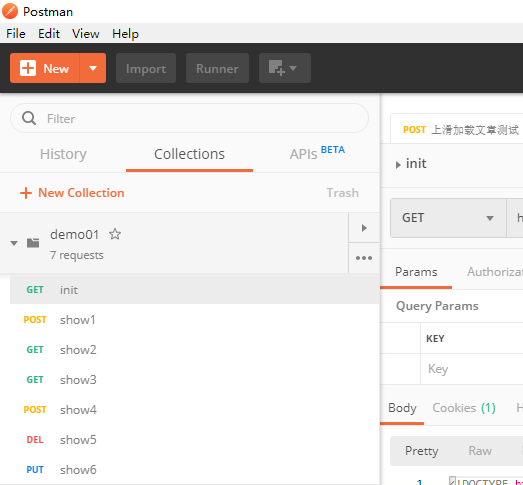
Get方式请求:
@RequestMapping(value = "/init")//二级目录
public String init() {
System.out.println("==========进入了springMVC的控制器=========");
System.out.println("返回业务层,调用持久层");
return "success";//返回方法执行完要跳转的页面名称
}
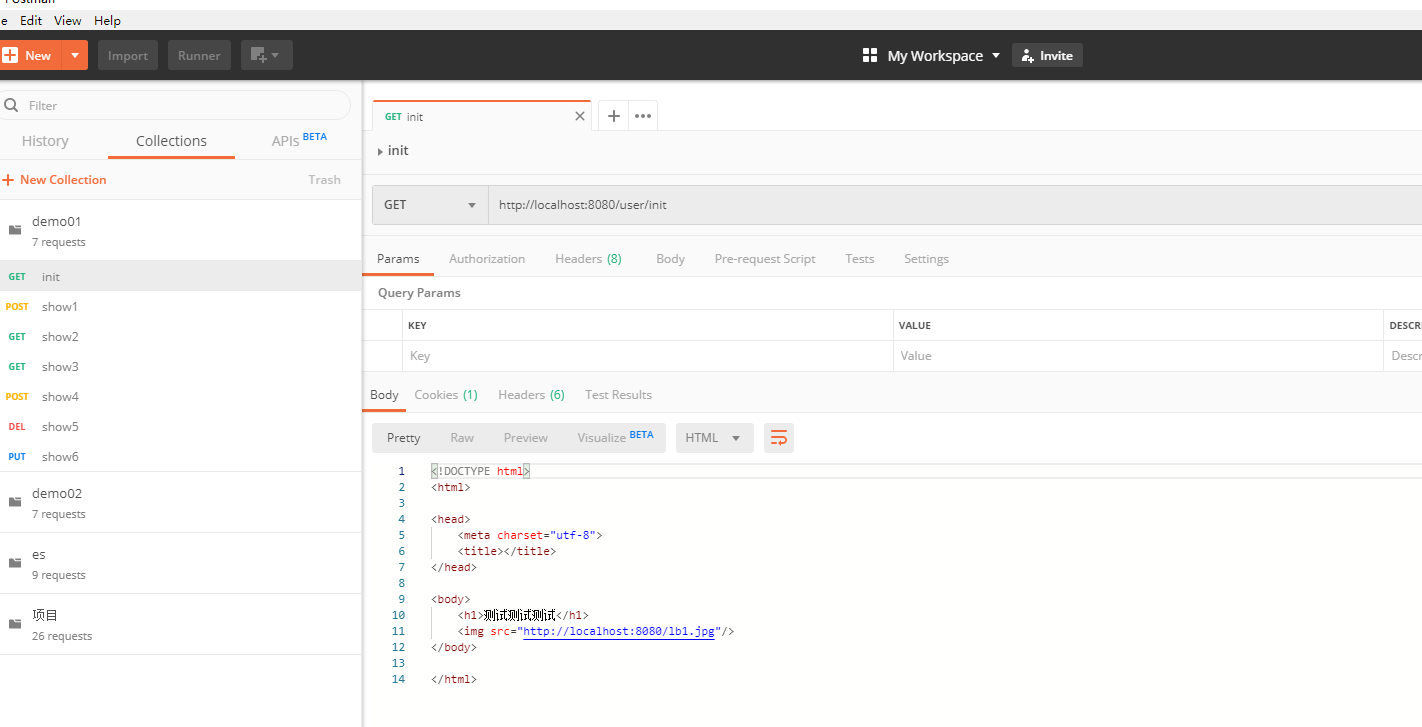

Post方式请求
package com.stringzhua.springboot_web_demo01.controller;
import org.springframework.stereotype.Controller;
import org.springframework.web.bind.annotation.*;
/**
* @Author Stringzhua
* @Date 2024/9/18 12:05
* description:
*/
@Controller
@RequestMapping("/user")//一级目录
public class UserController {
/**
* @RequestMapping 意义:处理用户的请求,相似于doget与dopost
* 位置:
* 类上:一级目录
* 方法:二级目录
* 例如:user/save
* user/delete
* student/save
* student/delete
* 属性:
* value = "",path = "" value等同于path,只有它时可省略
* 表示请求路径
* =========================
* method=常量,此请求的类型(get,post),若不设置则此请求适配所有的请求方式
* =========================
* params = ""
* 限制请求参数,例如:params={"msg1","msg2"}表示请求路径中必须携带参数名为msg1与msg2的参数
* 注意:1.超链接默认发送的是get请求
* 2.所有请求所携带的参数格式均为:key = value
* @DeleteMapping 删除
* @PutMapping 修改
* @GetMapping 查询
* @PostMapping 新增
* @RequestMapping 可以点击查看源码
* @Target({ElementType.METHOD,ElementType.TYPE}) METHOD==代表修饰方法,TYPE==代表修饰类
*/
@RequestMapping(value = "/show1", method = {RequestMethod.POST})
public String show1() {
System.out.println("==========进入了springMVC的控制器=========");
System.out.println("使用post方式发送请求访问show1");
return "success";
}
}
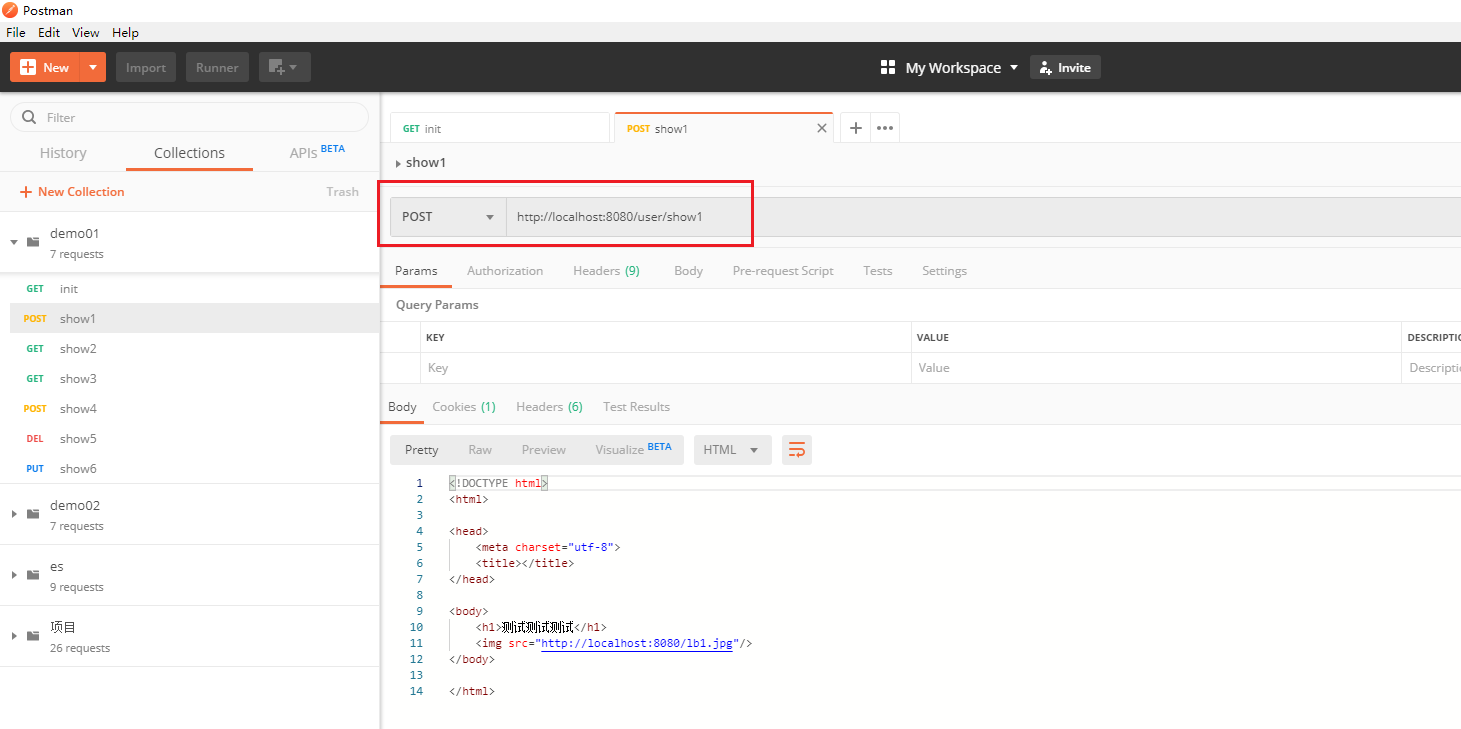

限制请求携带的参数
@RequestMapping(value = "/show2", params = {"param1=aa", "param2=bb"})
public String show2() {
System.out.println("==========进入了springMVC的控制器=========");
return "success";
}




@GetMapping
//postman测试
@GetMapping("/show3")
public String show3() {
System.out.println("==========进入了springMVC的控制器=========");
System.out.println("必须使用get方式请求[默认]查询");
return "success";
}
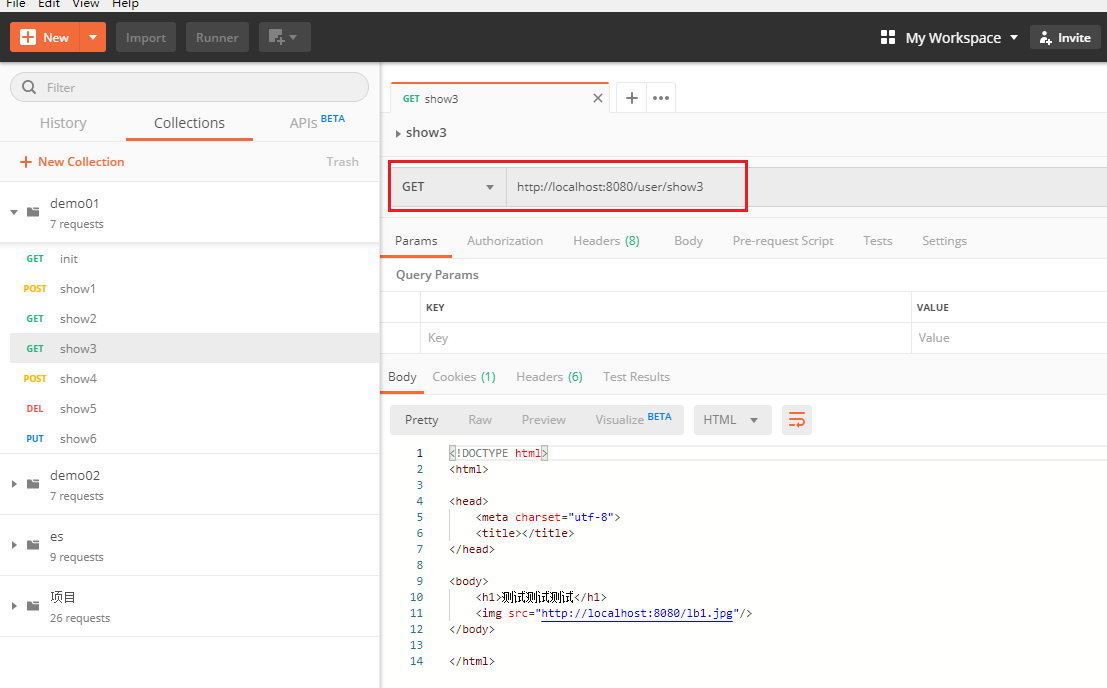

@PostMapping
@PostMapping("/show4")
public String show4() {
System.out.println("==========进入了springMVC的控制器=========");
System.out.println("必须使用post方式请求新增");
return "success";
}
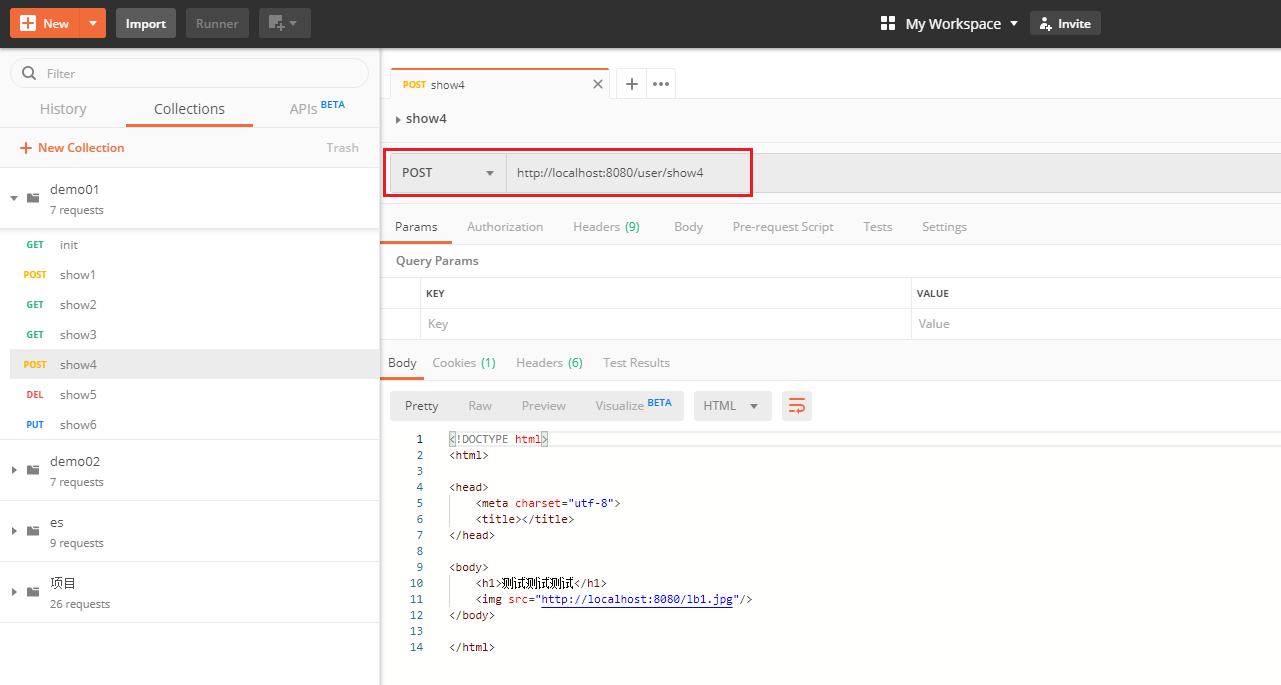

@DeleteMapping
@DeleteMapping("/show5")
public String show5() {
System.out.println("==========进入了springMVC的控制器=========");
System.out.println("必须使用delete方式请求删除");
return "success";
}
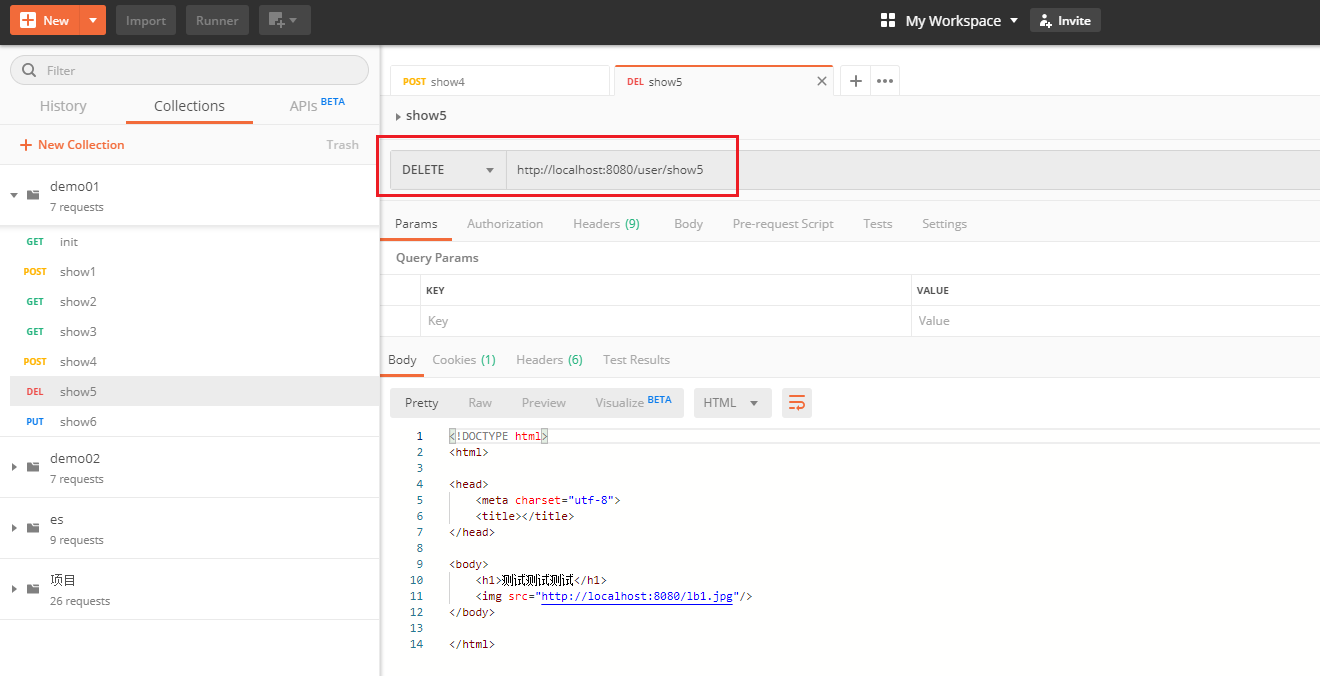

@PutMapping
@PutMapping("/show6")
public String show6() {
System.out.println("==========进入了springMVC的控制器=========");
System.out.println("必须使用put方式请求修改");
return "success";
}


SpringMVC-参数绑定
springMVC请求参数的绑定
绑定的机制:SpringMVC 绑定请求参数的过程是通过把表单提交请求参数,作为控制器中方法参数进行绑定的
支持数据类型:
1.基本类型参数:
包括基本类型和 String 类型
2.POJO类型参数:
包括实体类,以及关联的实体类
3.数组和集合类型参数:
包括 List 结构和 Map 结构的集合(包括数组)
4.使用 ServletAPI 对象作为方法参数
HttpServletRequest
HttpServletResponse
HttpSession
java.security.Principal
Locale
InputStream
OutputStream
Reader
Writer
使用要求
- 发送请求中携带数据的key与方法参数的name必须一致
- 数据类型合法
测试项目准备:
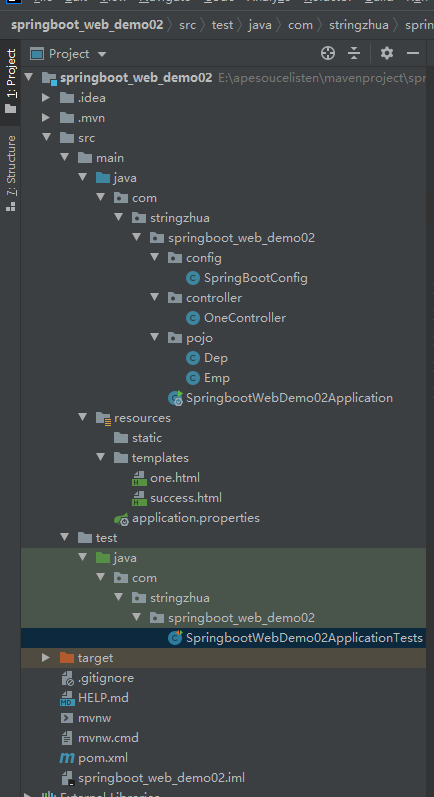
controller层OneController的完整代码:
package com.stringzhua.springboot_web_demo02.controller;
/**
* @Author Stringzhua
* @Date 2024/9/18 16:27
* description:
*/
import com.stringzhua.springboot_web_demo02.pojo.Dep;
import com.stringzhua.springboot_web_demo02.pojo.Emp;
import org.springframework.stereotype.Controller;
import org.springframework.web.bind.annotation.RequestMapping;
import org.springframework.web.bind.annotation.RequestParam;
import javax.servlet.ServletContext;
import javax.servlet.http.HttpServletRequest;
import javax.servlet.http.HttpServletResponse;
import javax.servlet.http.HttpSession;
import java.io.IOException;
import java.io.UnsupportedEncodingException;
import java.util.Arrays;
import java.util.List;
import java.util.Map;
/**
* springMVC请求参数的绑定
* 绑定的机制:SpringMVC 绑定请求参数的过程是通过把表单提交请求参数,作为控制器中方法参数进行绑定的
*
* 一.支持数据类型:
* 1.基本类型参数:
* 包括基本类型和 String 类型
* 2.POJO类型参数:
* 包括实体类,以及关联的实体类
* 3.数组和集合类型参数:
* 包括 List 结构和 Map 结构的集合(包括数组)
* 4.使用 ServletAPI 对象作为方法参数
* HttpServletRequest
* HttpServletResponse
* HttpSession
* java.security.Principal
* Locale
* InputStream
* OutputStream
* Reader
* Writer
*
* 二.使用要求
* 1.发送请求中携带数据的key与方法参数的name必须一致
* 2.数据类型合法
*
* */
@Controller
@RequestMapping("/one")
public class OneController {
//打开one的html页面
@RequestMapping("/show")
public String show(){
return "one";
}
/***********************基本类型和 String 类型作为参数*********************************/
@RequestMapping("/show1")
public String show1(String msg1){
System.out.println("接收到用户发送的数据为:" + msg1);
return "success";
}
@RequestMapping("/show2")
public String show2(String msg1,int msg2){
System.out.println("接收到用户发送的数据为:" + msg1);
System.out.println("接收到用户发送的数据为:" + msg2);
return "success";
}
/***********************POJO 类型作为参数*********************************/
//单一对象
@RequestMapping("/show3")
public String show3(Emp emp){
System.out.println("接收到用户发送的数据为:" + emp);
return "success";
}
//对象嵌套
@RequestMapping("/show4")
public String show4(Emp emp){
System.out.println("接收到用户发送的数据为:" + emp);
return "success";
}
//数组、map集合[list集合不行]
@RequestMapping("/map")
public String map(@RequestParam Map map){
System.out.println(map);
return "success";
}
/***********************POJO 类型中包含集合类型的参数*********************************/
@RequestMapping("/show5")
public String show5(Dep dep){
System.out.println("接受到用户发送数据为" + dep);
return "success";
}
@RequestMapping("/show6")
public String show6(int[] nums){
System.out.println("接受到用户发送数据为" + Arrays.toString(nums));
return "success";
}
/*********************使用 ServletAPI 对象作为方法参数*********************************/
@RequestMapping("/show7")
public String show7(HttpServletRequest request, HttpServletResponse response){
// request.setCharacterEncoding("UTF-8");
// response.setCharacterEncoding("UTF-8");
System.out.println(request);
System.out.println(response);
request.getParameter("msg1");
HttpSession session = request.getSession();
System.out.println(session);
session.setAttribute("","");
// try {
// response.sendRedirect("重定向");
// } catch (IOException e) {
// e.printStackTrace();
// }
ServletContext applaction = session.getServletContext();
return "success";
}
}
pojo下创建俩实体类:
Dep.java
package com.stringzhua.springboot_web_demo02.pojo;
import java.util.List;
import java.util.Map;
/**
* @Author Stringzhua
* @Date 2024/9/18 16:38
* description:
*/
public class Dep {
private int did;
private String dname;
//依赖员工集合
private List<Emp> mylist;
private Map<String, Emp> myMap;
@Override
public String toString() {
return "Dep{" +
"did=" + did +
", dname='" + dname + '\'' +
", mylist=" + mylist +
", myMap=" + myMap +
'}';
}
public int getDid() {
return did;
}
public void setDid(int did) {
this.did = did;
}
public String getDname() {
return dname;
}
public void setDname(String dname) {
this.dname = dname;
}
public List<Emp> getMylist() {
return mylist;
}
public void setMylist(List<Emp> mylist) {
this.mylist = mylist;
}
public Map<String, Emp> getMyMap() {
return myMap;
}
public void setMyMap(Map<String, Emp> myMap) {
this.myMap = myMap;
}
}
Emp.java
package com.stringzhua.springboot_web_demo02.pojo;
/**
* @Author Stringzhua
* @Date 2024/9/18 16:37
* description:
*/
public class Emp {
private int eid;
private String ename;
private String esex;
//emp依赖的dep对象
private Dep dept;
@Override
public String toString() {
return "Emp{" +
"eid=" + eid +
", ename='" + ename + '\'' +
", esex='" + esex + '\'' +
", dept=" + dept +
'}';
}
public int getEid() {
return eid;
}
public void setEid(int eid) {
this.eid = eid;
}
public String getEname() {
return ename;
}
public void setEname(String ename) {
this.ename = ename;
}
public String getEsex() {
return esex;
}
public void setEsex(String esex) {
this.esex = esex;
}
public Dep getDept() {
return dept;
}
public void setDept(Dep dept) {
this.dept = dept;
}
}
配置类同上,templates下创建两个页面
one.html
<!DOCTYPE html>
<html lang="cn" xmlns:th="http://www.thymeleaf.org">
<head>
<title>Title</title>
</head>
<body>
<h1>springMVC控制器方法参数作用:接受用户请求中的数据</h1>
<hr/>
<h3>基本类型和 String 类型作为参数</h3>
<a href="/one/show1?msg1=9527">发送请求1</a>
<a href="/one/show2?msg1=jdk&msg2=9527">发送请求2</a>
<h3>POJO 类型作为参数</h3>
<a href="/one/show3?eid=1&ename=郭凡&esex=小奶狗">发送请求3</a>
<form action="/one/show4" method="post">
员工编号:<input type="text" name="eid" ><br/>
员工姓名:<input type="text" name="ename" ><br/>
员工性别:<input type="text" name="esex" ><br/>
部门编号:<input type="text" name="dept.did" ><br/>
部门名称:<input type="text" name="dept.dname" ><br/>
<input type="submit" value="发送请求4"/>
</form>
<form action="/one/map" method="post">
员工编号:<input type="text" name="eids"><br/>
员工姓名:<input type="text" name="enames"><br/>
员工性别:<input type="text" name="esexs"><br/>
<input type="submit" value="发送请求4(map)"/>
</form>
<h3>POJO 类中包含集合类型参数</h3>
<form action="/one/show5" method="post">
部门编号:<input type="text" name="did" ><br/>
部门名称:<input type="text" name="dname" ><br/>
员工编号1:<input type="text" name="mylist[0].eid" ><br/>
员工姓名1:<input type="text" name="mylist[0].ename" ><br/>
员工性别1:<input type="text" name="mylist[0].esex" ><br/>
员工编号2:<input type="text" name="mylist[1].eid" ><br/>
员工姓名2:<input type="text" name="mylist[1].ename" ><br/>
员工性别2:<input type="text" name="mylist[1].esex" ><br/>
员工编号3:<input type="text" name="myMap['one'].eid" ><br/>
员工姓名3:<input type="text" name="myMap['one'].ename" ><br/>
员工性别3:<input type="text" name="myMap['one'].esex" ><br/>
员工编号4:<input type="text" name="myMap['two'].eid" ><br/>
员工姓名4:<input type="text" name="myMap['two'].ename" ><br/>
员工性别4:<input type="text" name="myMap['two'].esex" ><br/>
<input type="submit" value="发送请求5"/>
</form>
<a href="/one/show6?nums=123&nums=456&nums=789">发送请求6</a>
<h3>使用 ServletAPI 对象作为方法参数</h3>
<a href="/one/show7">发送请求7</a>
</body>
</html>
success.html
<!DOCTYPE html>
<head>
<meta charset="UTF-8">
<title>success</title>
</head>
<body>
<h1>spring成功页面</h1>
</body>
</html>
基本类型和 String 类型作为参数
OneController
单个参数
package com.stringzhua.springboot_web_demo02.controller;
/**
* @Author Stringzhua
* @Date 2024/9/18 16:27
* description:
*/
import com.stringzhua.springboot_web_demo02.pojo.Dep;
import com.stringzhua.springboot_web_demo02.pojo.Emp;
import org.springframework.stereotype.Controller;
import org.springframework.web.bind.annotation.RequestMapping;
import org.springframework.web.bind.annotation.RequestParam;
import javax.servlet.ServletContext;
import javax.servlet.http.HttpServletRequest;
import javax.servlet.http.HttpServletResponse;
import javax.servlet.http.HttpSession;
import java.io.IOException;
import java.io.UnsupportedEncodingException;
import java.util.Arrays;
import java.util.List;
import java.util.Map;
/**
* springMVC请求参数的绑定
* 绑定的机制:SpringMVC 绑定请求参数的过程是通过把表单提交请求参数,作为控制器中方法参数进行绑定的
*
* 一.支持数据类型:
* 1.基本类型参数:
* 包括基本类型和 String 类型
* 2.POJO类型参数:
* 包括实体类,以及关联的实体类
* 3.数组和集合类型参数:
* 包括 List 结构和 Map 结构的集合(包括数组)
* 4.使用 ServletAPI 对象作为方法参数
* HttpServletRequest
* HttpServletResponse
* HttpSession
* java.security.Principal
* Locale
* InputStream
* OutputStream
* Reader
* Writer
*
* 二.使用要求
* 1.发送请求中携带数据的key与方法参数的name必须一致
* 2.数据类型合法
*
* */
@Controller
@RequestMapping("/one")
public class OneController {
//打开one的html页面
@RequestMapping("/show")
public String show(){
return "one";
}
/***********************基本类型和 String 类型作为参数*********************************/
@RequestMapping("/show1")
public String show1(String msg1){
System.out.println("接收到用户发送的数据为:" + msg1);
return "success";
}
}
访问http://localhost:8080/one/show
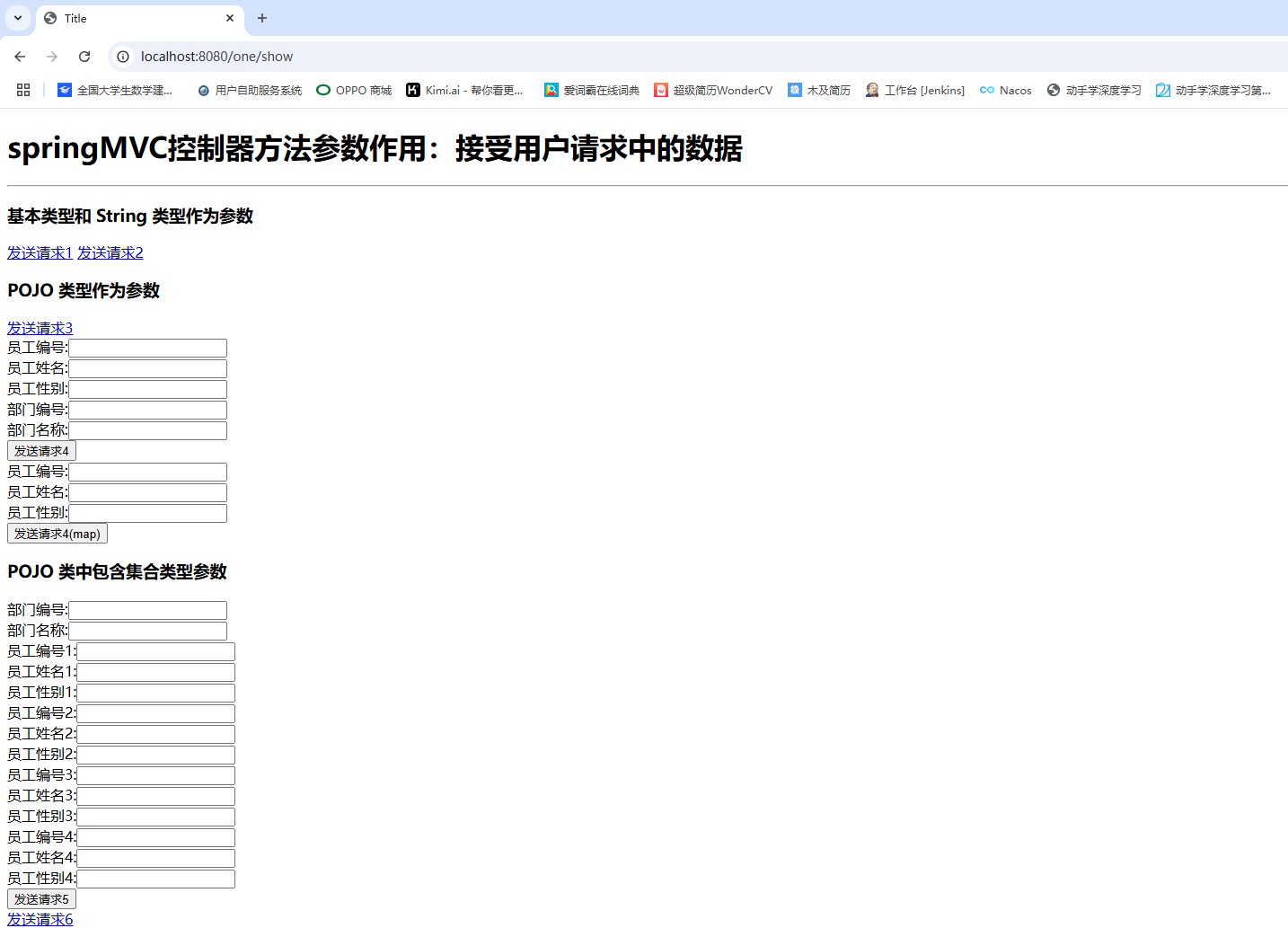
进入主页面,点击发送请求1


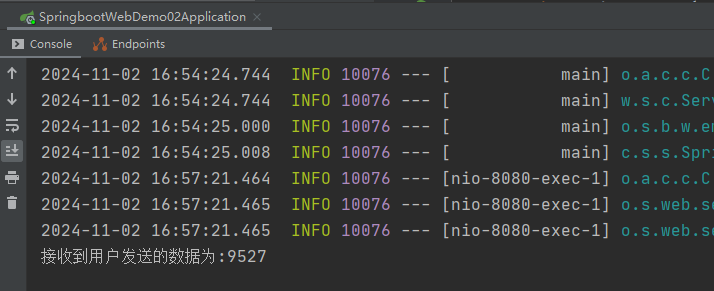
多个参数
@RequestMapping("/show2")
public String show2(String msg1,int msg2){
System.out.println("接收到用户发送的数据为:" + msg1);
System.out.println("接收到用户发送的数据为:" + msg2);
return "success";
}
进入主页面,点击发送请求2:




POJO类型作为参数
单一对象
/***********************POJO 类型作为参数*********************************/
//单一对象
@RequestMapping("/show3")
public String show3(Emp emp){
System.out.println("接收到用户发送的数据为:" + emp);
return "success";
}
进入主页面,点击发送请求3:
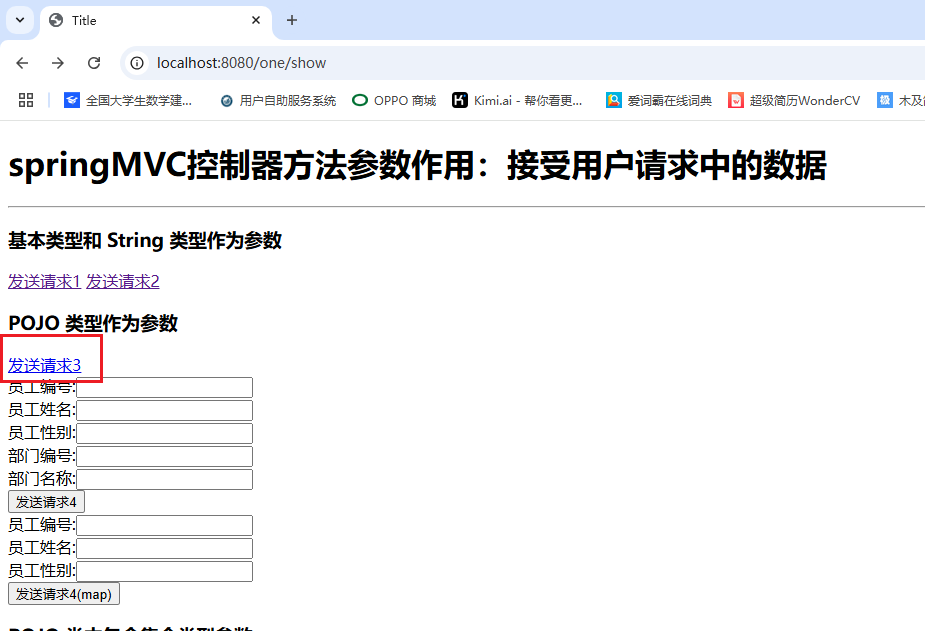

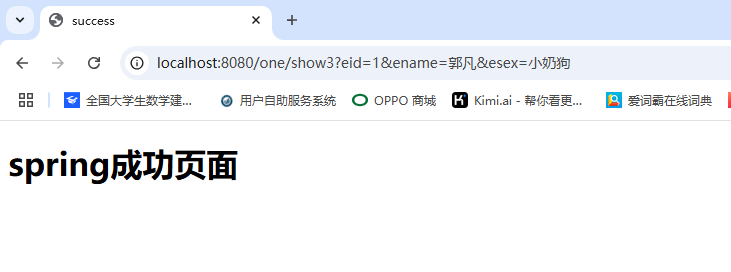

对象嵌套
//对象嵌套
@RequestMapping("/show4")
public String show4(Emp emp){
System.out.println("接收到用户发送的数据为:" + emp);
return "success";
}
进入主页面,填写表单,点击发送请求4:
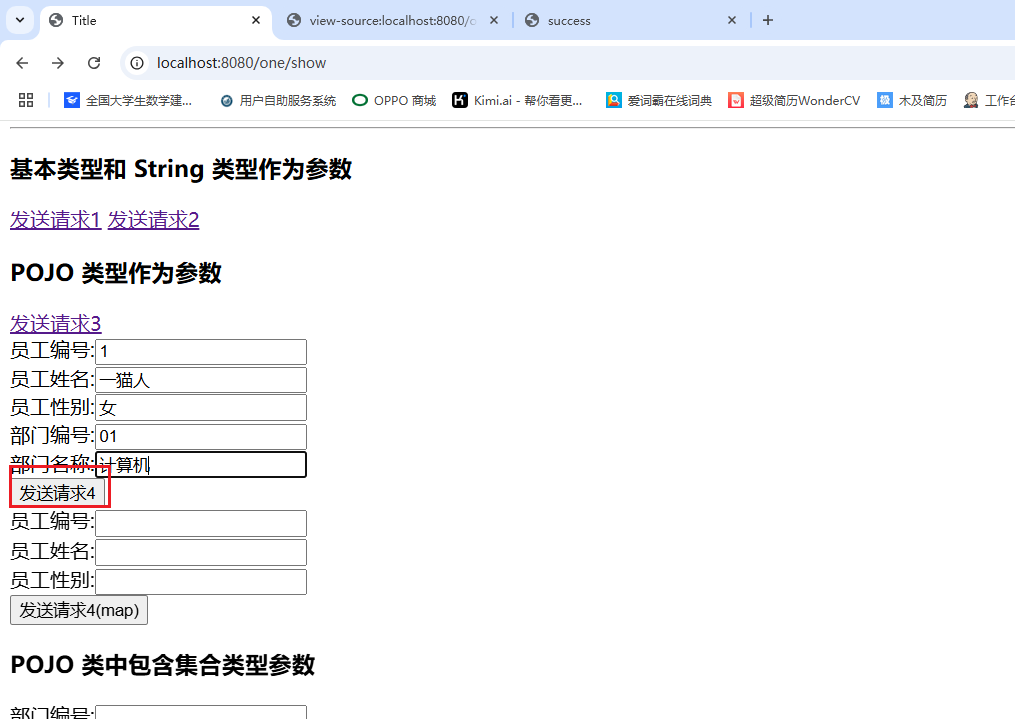

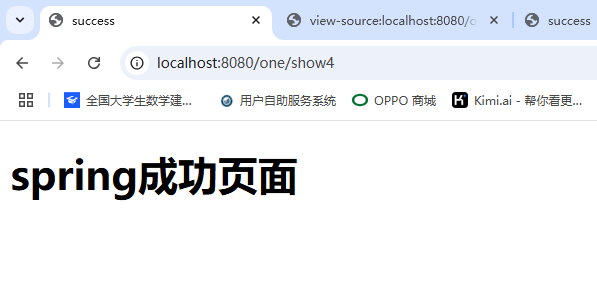

@RequestParam
//数组、map集合[list集合不行]
@RequestMapping("/map")
public String map(@RequestParam Map map){
System.out.println(map);
return "success";
}
进入主界面,填写表单,点击发送请求4(map)
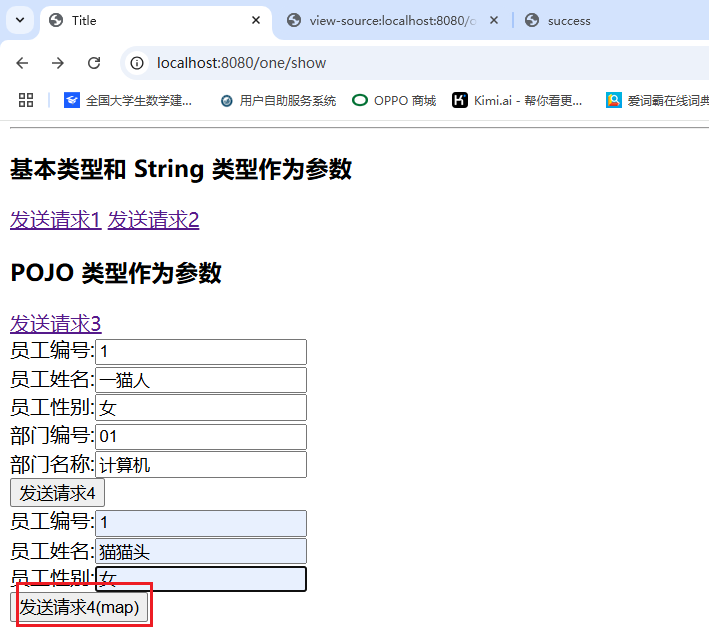

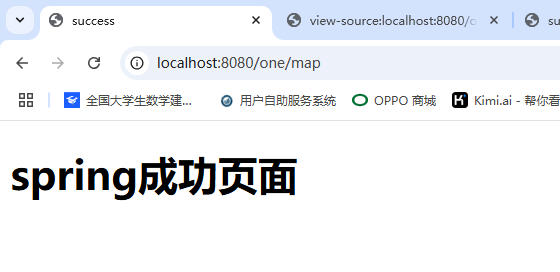

POJO 类中包含集合类型参数
/***********************POJO 类型中包含集合类型的参数*********************************/
@RequestMapping("/show5")
public String show5(Dep dep){
System.out.println("接受到用户发送数据为" + dep);
return "success";
}
进入主页面,填写表单,点击发送请求5:
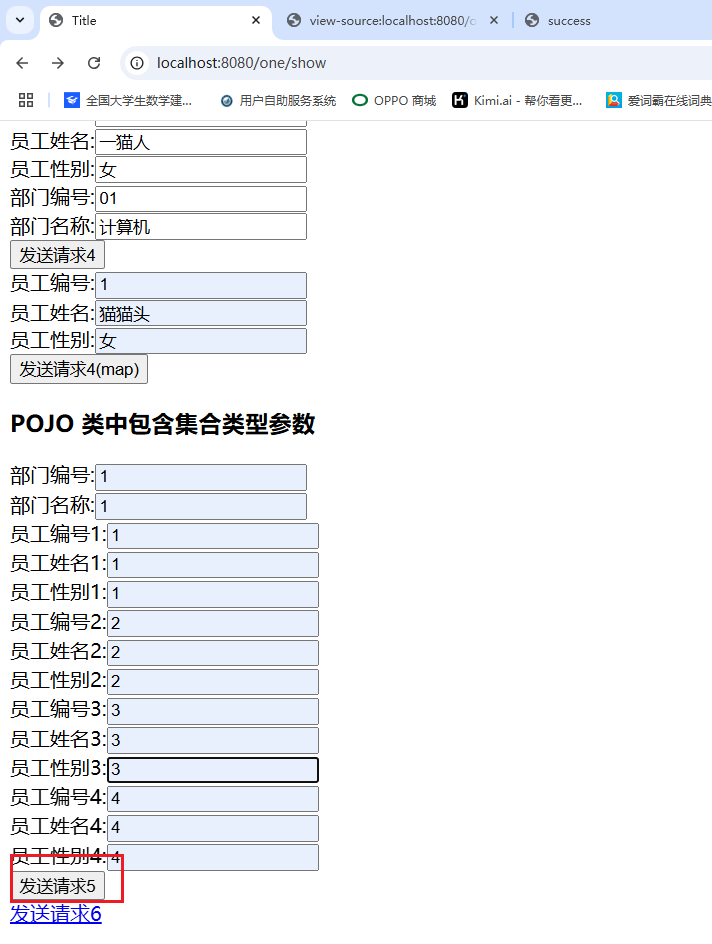
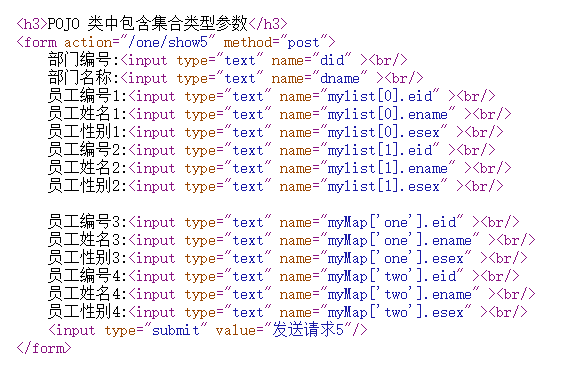
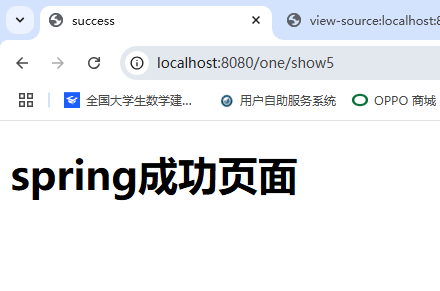

@RequestMapping("/show6")
public String show6(int[] nums){
System.out.println("接受到用户发送数据为" + Arrays.toString(nums));
return "success";
}
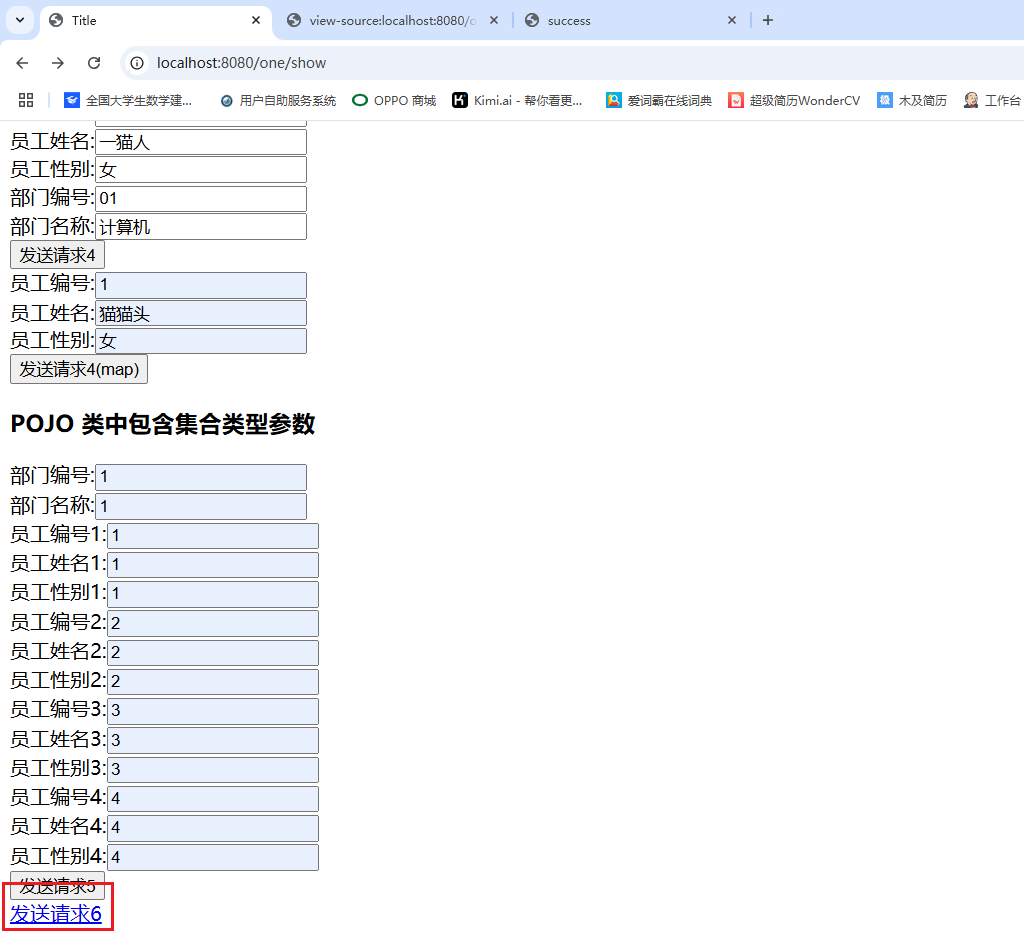



使用 ServletAPI 对象作为方法参数
/*********************使用 ServletAPI 对象作为方法参数*********************************/
@RequestMapping("/show7")
public String show7(HttpServletRequest request, HttpServletResponse response){
// request.setCharacterEncoding("UTF-8");
// response.setCharacterEncoding("UTF-8");
System.out.println(request);
System.out.println(response);
request.getParameter("msg1");
HttpSession session = request.getSession();
System.out.println(session);
session.setAttribute("","");
// try {
// response.sendRedirect("重定向");
// } catch (IOException e) {
// e.printStackTrace();
// }
ServletContext applaction = session.getServletContext();
return "success";
}




SpringMVC-常用注解
@RequestParam
作用:
- 把请求中指定名称的参数给控制器中的形参赋值。
- 如果页面标签名称和方法参数名称不一致,可以使用此注解实现
属性:
- name属性:设置参数名称
- defaultValue属性:设置默认值
- required属性:设置是否为必传
测试:
项目结构:

name属性
单个参数
package com.stringzhua.springboot_web_demo03.controller;
/**
* @Author Stringzhua
* @Date 2024/9/18 22:49
* description:
*/
import com.stringzhua.springboot_web_demo03.pojo.Emp;
import org.springframework.stereotype.Controller;
import org.springframework.web.bind.annotation.*;
/**
* springMVC常用注解
*
* 一.@RequestParam
* 作用:
* 把请求中指定名称的参数给控制器中的形参赋值。
* 如果页面标签名称和方法参数名称不一致,可以使用此注解实现
* 属性:
* name属性:设置参数名称
* defaultValue属性:设置默认值
* required属性:设置是否为必传
*
* 二.@RequestBody json
* 作用:
* 用于获取"请求体"内容。直接使用得到是 key=value&key=value...
* 结构的数据,并可以转换为对象
* 属性:
* required:是否必须有请求体。默认值是:true。
*
*
*
* 三.@PathVaribale
* 作用:
* 用于绑定 url 中的占位符。例如:请求 url 中 /delete/{id},
* 这个{id}就是 url 占位符。url 支持占位符是 spring3.0 之
* 后加入的。是 springmvc 支持 rest 风格 URL 的一个重要标志
* 属性:
* value:用于指定 url 中占位符名称。
* required:是否必须提供占位符。
*
* Restful是一种软件架构风格、设计风格,而不是标准,只是提供了一组设计原则和约束条件。
* 主要用于客户端和服务器交互类的软件,基于这个风格设计的软件可以更简洁,更有层次,
* 更易于实现缓存机制等。
*
* Restful风格的请求是使用“url+请求方式”表示一次请求目的的,HTTP 协议里面四个表示操作方式的动词如下:
* GET:用于获取资源
* POST:用于新建资源
* PUT:用于更新资源
* DELETE:用于删除资源
* 例如:
* /users/1 GET : 得到 id = 1 的 user
* /users/1 DELETE: 删除 id = 1 的 user
* /users/1/新名/新性 PUT: 更新 id = 1 的 user
* /users/新名/新性 POST: 新增 user
*
* */
@Controller
@RequestMapping("/one")
public class OneController {
@RequestMapping("/show1")
public String show1(@RequestParam(name = "msg1") String msg){
System.out.println("接收到用户发送数据为" + msg);
return "success";
}
}
使用postman测试:
es.postman_collection.json
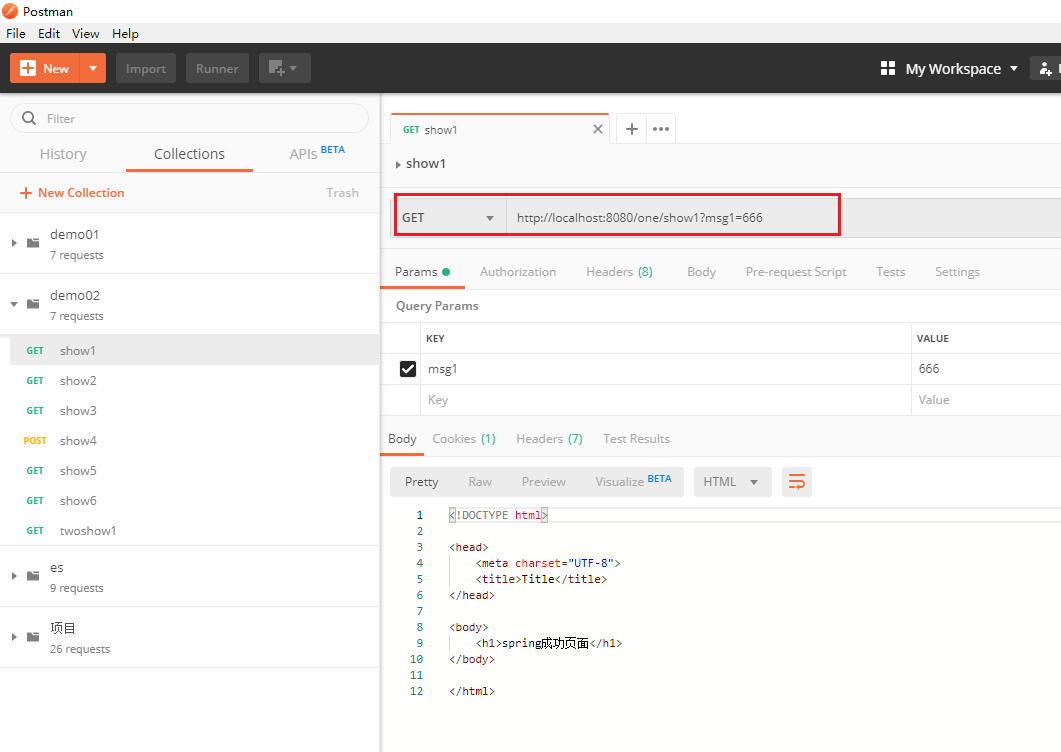
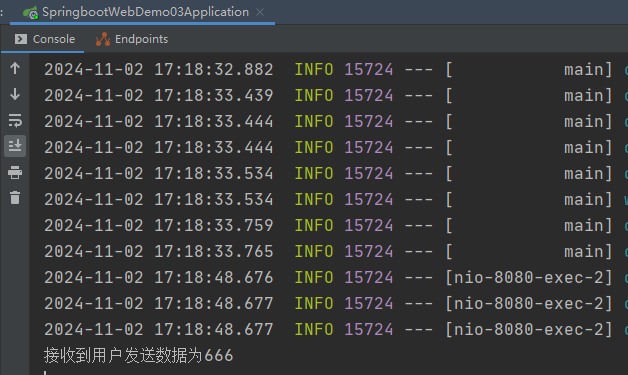
多个参数
@RequestMapping("/show2")
public String show2(@RequestParam("msg1") String msg,@RequestParam("msg2") String num){
System.out.println("接收到用户发送数据为" + msg);
System.out.println("接收到用户发送数据为" + num);
return "success";
}
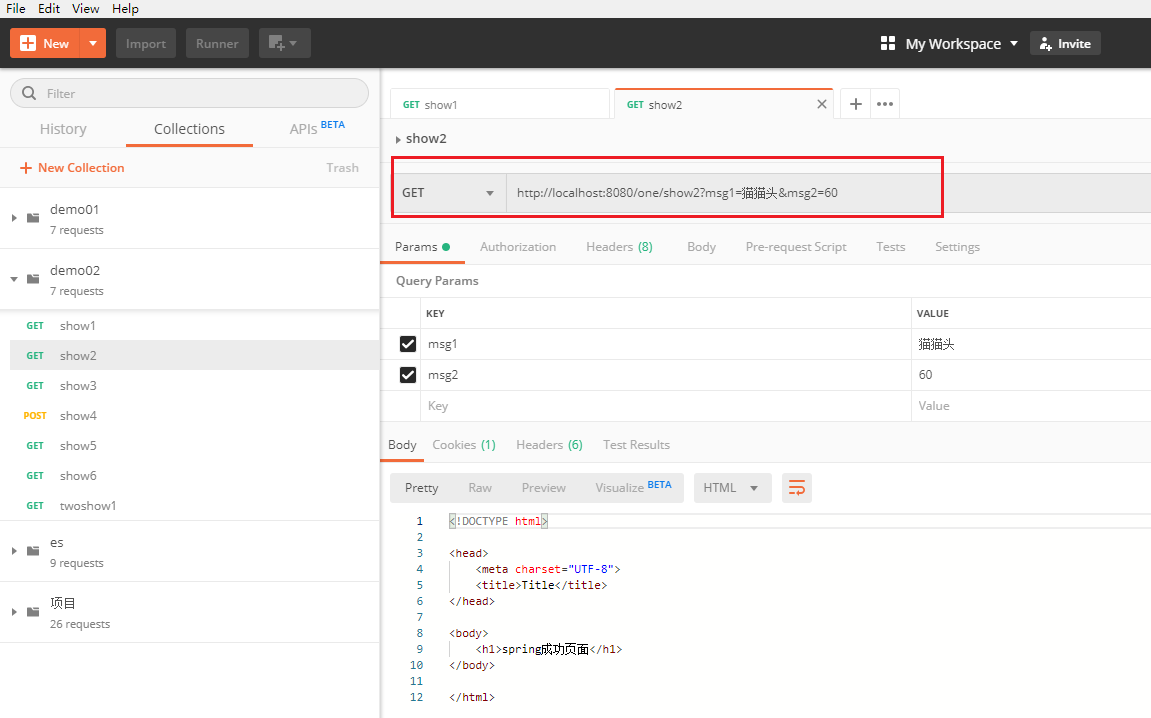
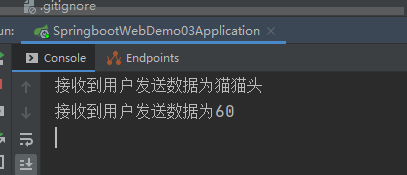
defaultValue属性:设置默认值
@RequestMapping("/show3")
public String show3(@RequestParam(name = "uname",defaultValue = "暂无用户") String name){
System.out.println("用户名"+name);
return "success";
}
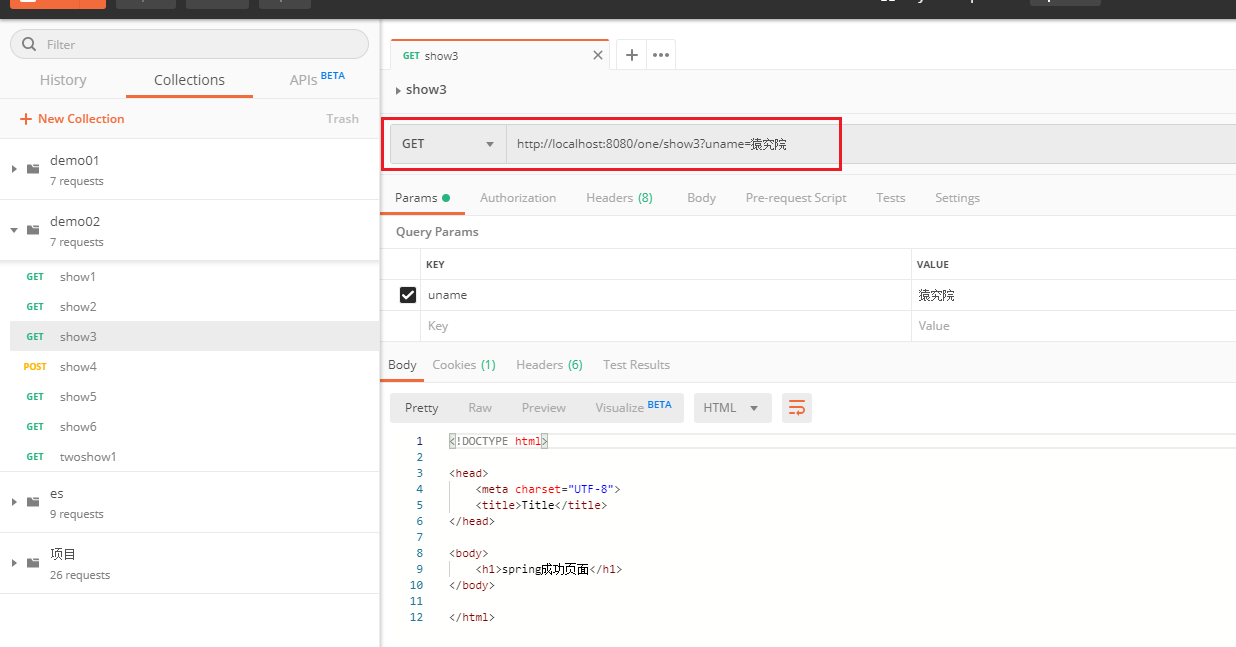

如果不传参数,测试:
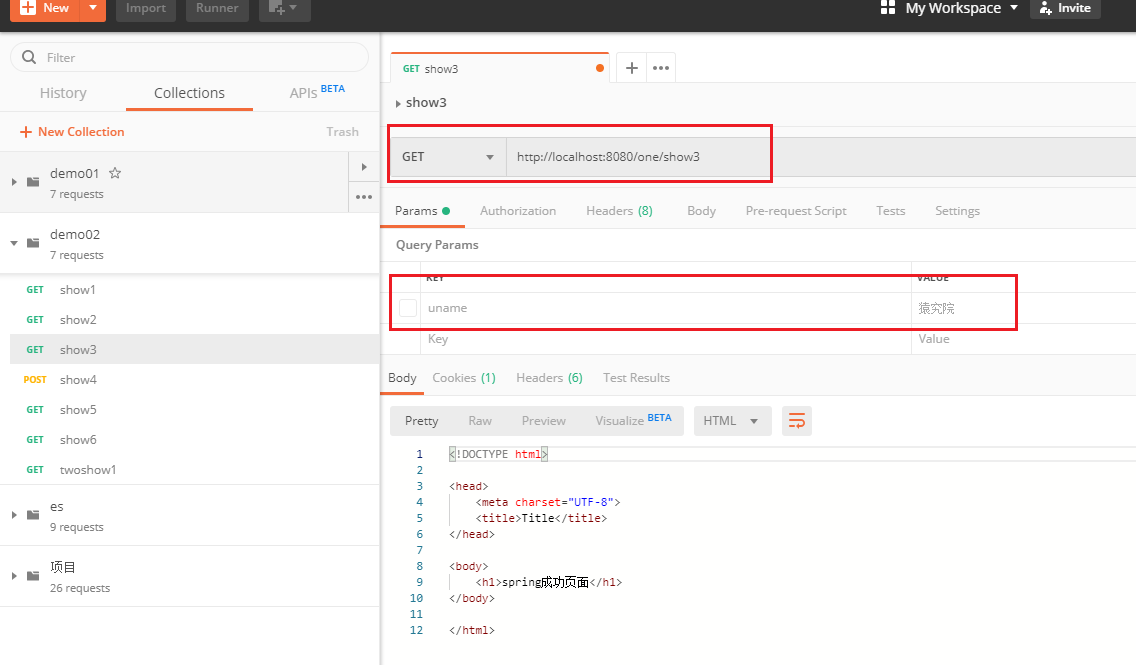

@RequestBody
作用:
- 用于获取"请求体"内容。直接使用得到是 key=value&key=value…
- 结构的数据,并可以转换为对象
属性:
- required:是否必须有请求体。默认值是:true。
测试:
/**
* 前后端分离
* @RequestBody可以将json ===》 javaBean
* 注意:
* 1.前端不能使用GET方式提交数据,GET方式无请求体
* {
* "eid":007,
* "ename":"詹姆斯邦德",
* "esex":"绅士"
* }
*
* * */
//RequestBody注解解析json字符串,要求json字段直接使用得到key=value&
@RequestMapping("/show4")
public String show4(@RequestBody Emp emp){
System.out.println(emp);
return "success";
}


@PathVariable
作用:
- 用于绑定 url 中的占位符。例如:请求 url 中 /delete/{id},
- 这个{id}就是 url 占位符。url 支持占位符是 spring3.0 之后加入的,是 springmvc 支持 rest 风格 URL 的一个重要标志
属性:
value:用于指定 url 中占位符名称。
required:是否必须提供占位符。
测试:
@RequestMapping("/show5/{uname}/{pwd}")
public String show5(@PathVariable("uname")String msg1,@PathVariable("pwd")String msg2){
System.out.println(msg1);
System.out.println(msg2);
return "success";
}

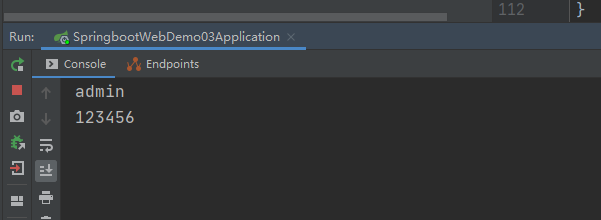
当参数名和字段名相同时,省略@PathVariable()括号中的内容,进行简写
@RequestMapping("/show6/{uname}/{pwd}")
public String show6(@PathVariable String uname,@PathVariable String pwd){
System.out.println(uname);
System.out.println(pwd);
return "success";
}

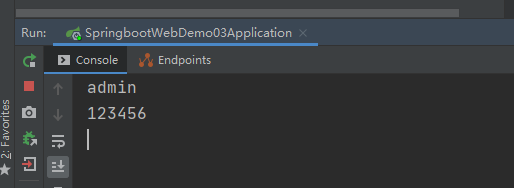
restFul
Restful是一种软件架构风格、设计风格,而不是标准,只是提供了一组设计原则和约束条件。
主要用于客户端和服务器交互类的软件,基于这个风格设计的软件可以更简洁,更有层次,
更易于实现缓存机制等。
Restful风格的请求是使用“url+请求方式”表示一次请求目的的,HTTP 协议里面四个表示操作方式的动词如下:
- GET:用于获取资源
- POST:用于新建资源
- PUT:用于更新资源
- DELETE:用于删除资源
例如:
- /users/1 GET : 得到 id = 1 的 user
- /users/1 DELETE: 删除 id = 1 的 user
- /users/1/新名/新性 PUT: 更新 id = 1 的 user
- /users/新名/新性 POST: 新增 user
@RequestHeader
**作用:**用于获取请求消息头。
属性:
value:提供消息头名称
required:是否必须有此消息头
测试:
package com.stringzhua.springboot_web_demo03.controller;
import org.springframework.stereotype.Controller;
import org.springframework.web.bind.annotation.CookieValue;
import org.springframework.web.bind.annotation.RequestHeader;
import org.springframework.web.bind.annotation.RequestMapping;
/**
* @Author Stringzhua
* @Date 2024/9/19 10:38
* description:
*/
/**
*
* springMVC常用注解
*
* 四.@RequestHeader
* 作用:
* 用于获取请求消息头。
* 属性:
* value:提供消息头名称
* required:是否必须有此消息头
* 五.@CookieValue
* 作用:
* 用于把指定 cookie 名称的值传入控制器方法参数。
* 属性:
* value:指定 cookie 的名称。
* required:是否必须有此 cookie。
*
* */
@Controller
@RequestMapping("/two")
public class TwoController {
/**
* 获取头信息
* @param msg
* @return
*/
@RequestMapping("/show1")
public String show1(@RequestHeader(value = "msg1") String msg){
System.out.println(msg);
return "success";
}
}
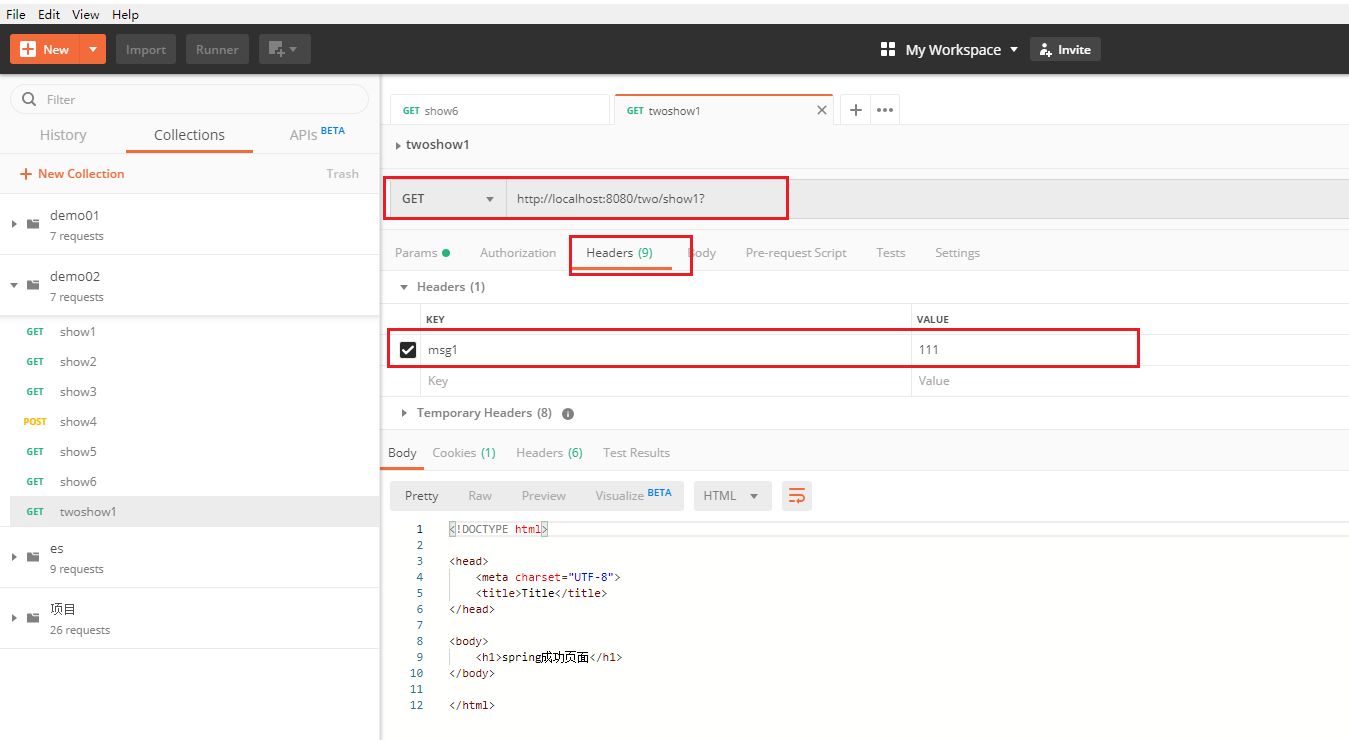

@CookieValue
**作用:**用于把指定 cookie 名称的值传入控制器方法参数。
属性:
value:指定 cookie 的名称。
required:是否必须有此 cookie
测试:
/**
* 获取cookie
*/
@RequestMapping("/show2")
public String show2(@CookieValue(value = "JSESSIONID",required = false)String jsonid){
System.out.println(jsonid);
return "success";
}
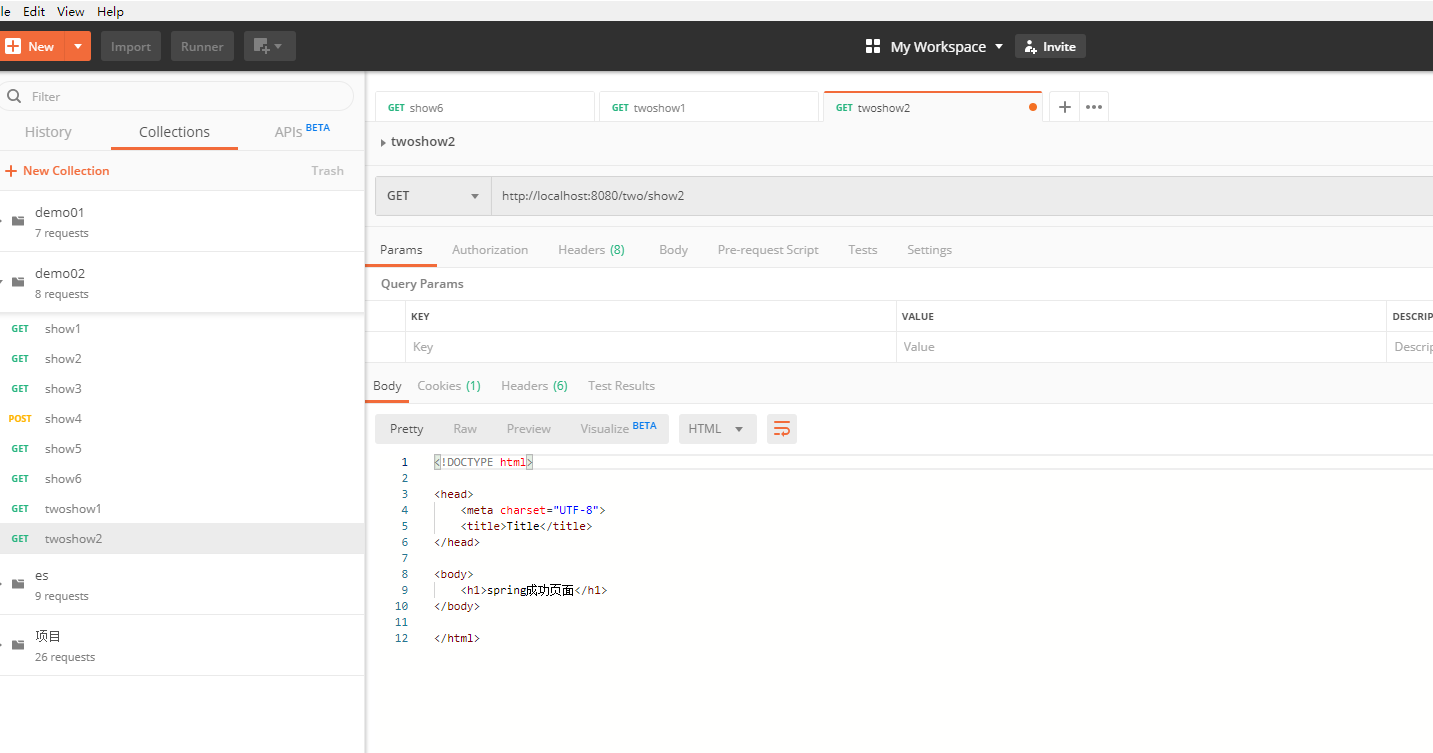

SpringMVC-数据传递
准备工作:
index.html
<!DOCTYPE html>
<html lang="cn">
<head>
<title>Title</title>
</head>
<body>
<h3>springMVC控制器返回字符串</h3>
<a href="/string/show1">发送请求1</a><br/>
<a href="/string/show2">发送请求2</a><br/>
<a href="/string/show3">发送请求3</a><br/>
<a href="/string/show4">发送请求4</a><br/>
<hr/>
<h3>springMVC控制器返回json字符串</h3>
<a href="/json/show1">发送请求1</a><br/>
<a href="/json/show2">发送请求2</a><br/>
</body>
</html>
success_String.html
注意 测试发送请求123时,将span标签删掉 要不然会报错
<!DOCTYPE html>
<html lang="cn">
<head>
<meta charset="UTF-8">
<title>Title</title>
</head>
<body>
<h1>返回值String成功页面</h1>
<!-- <span>#(session.emp.eid)</span>-->
<!-- <span>#(session.emp.ename)</span>-->
<!-- <span>#(session.emp.esex)</span><br/>-->
</body>
</html>
主页面
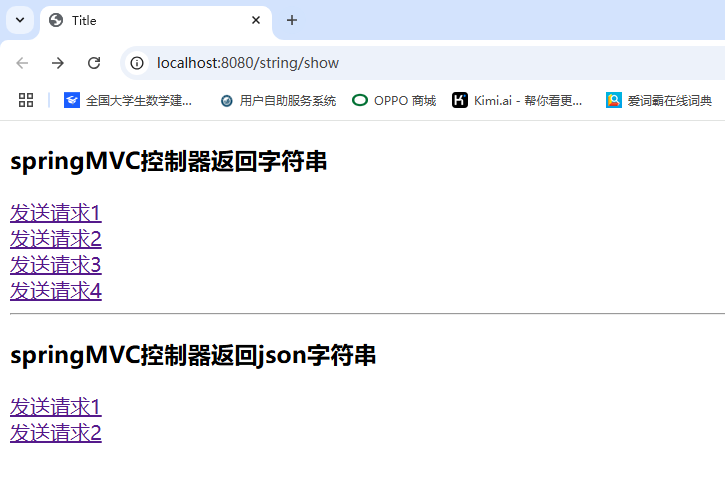
字符串
充当视图的逻辑名称,默认页面跳转为请求转发方式
package com.stringzhua.springboot_web_demo04.controller;
import com.stringzhua.springboot_web_demo04.pojo.Emp;
import org.springframework.stereotype.Controller;
import org.springframework.web.bind.annotation.RequestMapping;
import javax.servlet.http.HttpServletRequest;
/**
* @Author Stringzhua
* @Date 2024/9/19 11:20
* description:
*/
@Controller
@RequestMapping("/string")
public class StringController {
/**
* 进入首页
*/
@RequestMapping("/show")
public String show() {
return "index";
}
//请求转发
//充当试图的逻辑名称,默认页面跳转为请求转发方式
@RequestMapping("/show1")
public String show1() {
System.out.println("===show1转发...===");
return "success_String";
}
}
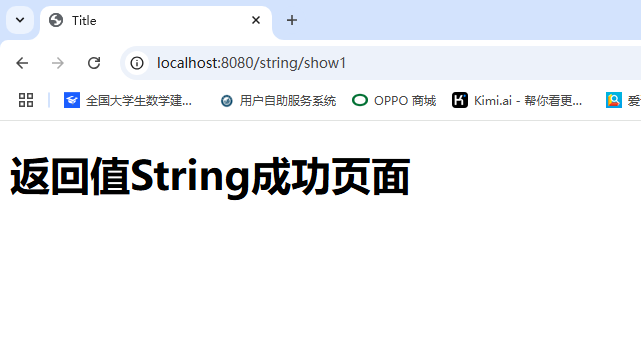
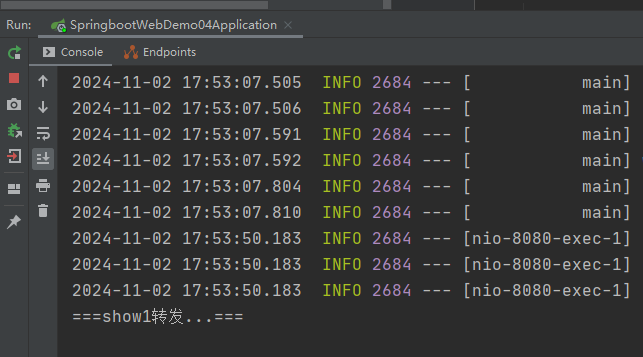
充当一次请求重定向
//作充当一次请求重定向,url地址改变,显示的页面改变
// http://localhost:8080/string/show1
@RequestMapping("/show2")
public String show2() {
System.out.println("===show2重定向===");
return "redirect:show1";
}

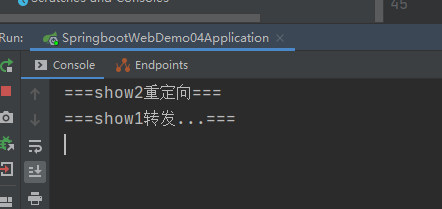
充当一次请求转发
//作充当一次请求转发,url地址不变,但显示的页面改变
// http://localhost:8080/string/show3
@RequestMapping("/show3")
public String show3() {
System.out.println("===show3转发===");
return "forward:show1";
}
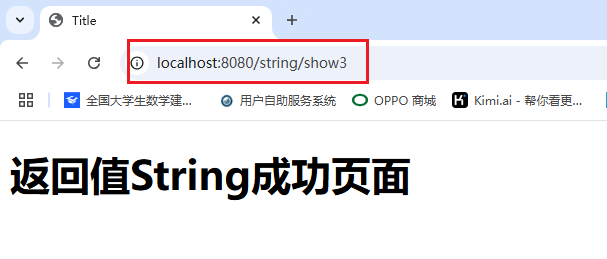
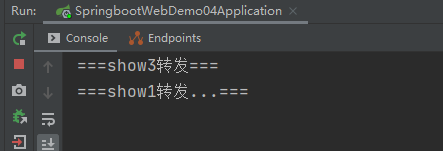
通过session传入数据.
先修改下页面:
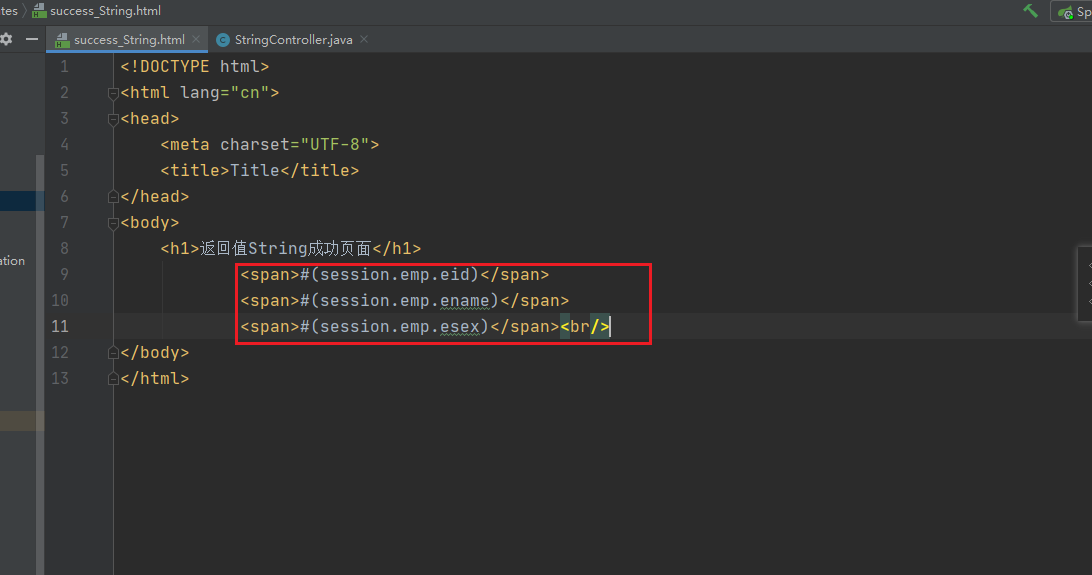
//ServletAPI
@RequestMapping("/show4")
public String show4(HttpServletRequest request) {
System.out.println("===show4===");
//模拟查询数据库
Emp emp = new Emp(1, "猫猫头", "男");
//设置session
request.getSession().setAttribute("emp", emp);
return "success_String";
}
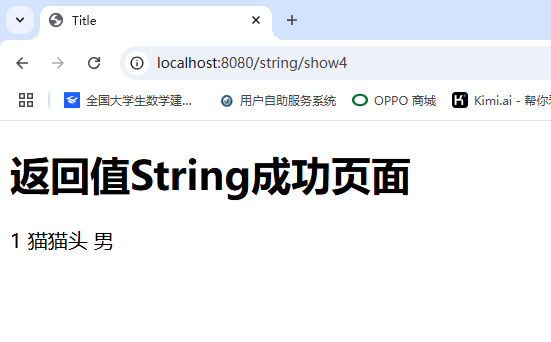
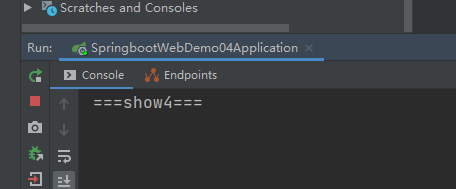
JSON
package com.stringzhua.springboot_web_demo04.controller;
import com.stringzhua.springboot_web_demo04.pojo.Emp;
import org.springframework.stereotype.Controller;
import org.springframework.web.bind.annotation.RequestBody;
import org.springframework.web.bind.annotation.RequestMapping;
import org.springframework.web.bind.annotation.ResponseBody;
import org.springframework.web.bind.annotation.RestController;
import java.util.ArrayList;
import java.util.HashMap;
import java.util.List;
import java.util.Map;
/**
* @Author Stringzhua
* @Date 2024/9/19 11:59
* description:
*/
/**
* @ResponseBody 对象====>json
* 位置:1.类
* 2.方法
* @RequestBody json====>对象
* 位置:方法参数
* @RestController = @Controller + @ResponseBody
*/
//@Controller
//@ResponseBody
@RestController
@RequestMapping("/json")
public class JsonController {
@RequestMapping("/show1")
@ResponseBody
public List<Emp> show1() {
List<Emp> list = new ArrayList<>();
Emp emp1 = new Emp(2, "柳永", "男");
Emp emp2 = new Emp(3, "橙橙", "男");
Emp emp3 = new Emp(1, "李郁", "女");
list.add(emp1);
list.add(emp2);
list.add(emp3);
return list;
}
@RequestMapping("/show2")
@ResponseBody//不加ResponseBody注解,就是逻辑地址的页面,加了就是json串,如果返回值是String类型不转,其他的都是json串
// public String show2(){
// return "特殊";
// }
// public int show2(){
// return 50;
// }
// public Emp show2() {
// return new Emp(1, "李郁", "女");
// }
public Map<String, Emp> show2() {
HashMap<String, Emp> map = new HashMap<>();
map.put("1", new Emp(2, "柳永", "男"));
map.put("2", new Emp(3, "橙橙", "男"));
map.put("3", new Emp(1, "李郁", "女"));
return map;
}
}
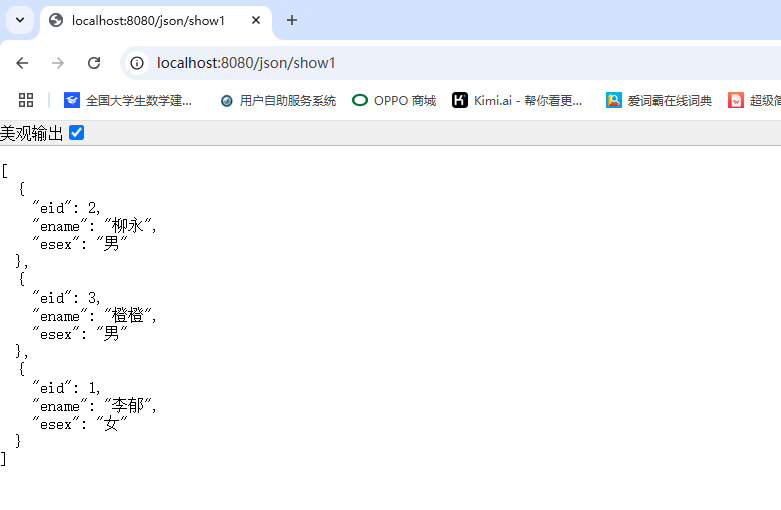
@RequestMapping("/show2")
@ResponseBody//不加ResponseBody注解,就是逻辑地址的页面,加了就是json串,如果返回值是String类型不转,其他的都是json串
public String show2(){
return "特殊";
}
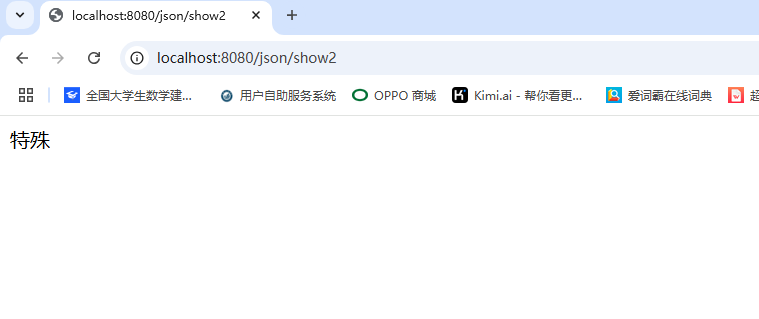
SpringMVC-文件上传
项目结构:
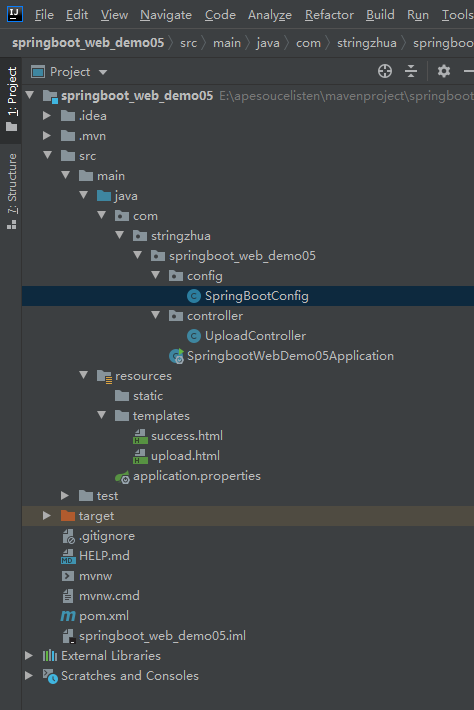
1.导入文件上传的坐标:
<!-- 文件上传-->
<dependency>
<groupId>commons-io</groupId>
<artifactId>commons-io</artifactId>
<version>2.6</version>
</dependency>
<dependency>
<groupId>commons-fileupload</groupId>
<artifactId>commons-fileupload</artifactId>
<version>1.3.3</version>
</dependency>
导入前端页面:
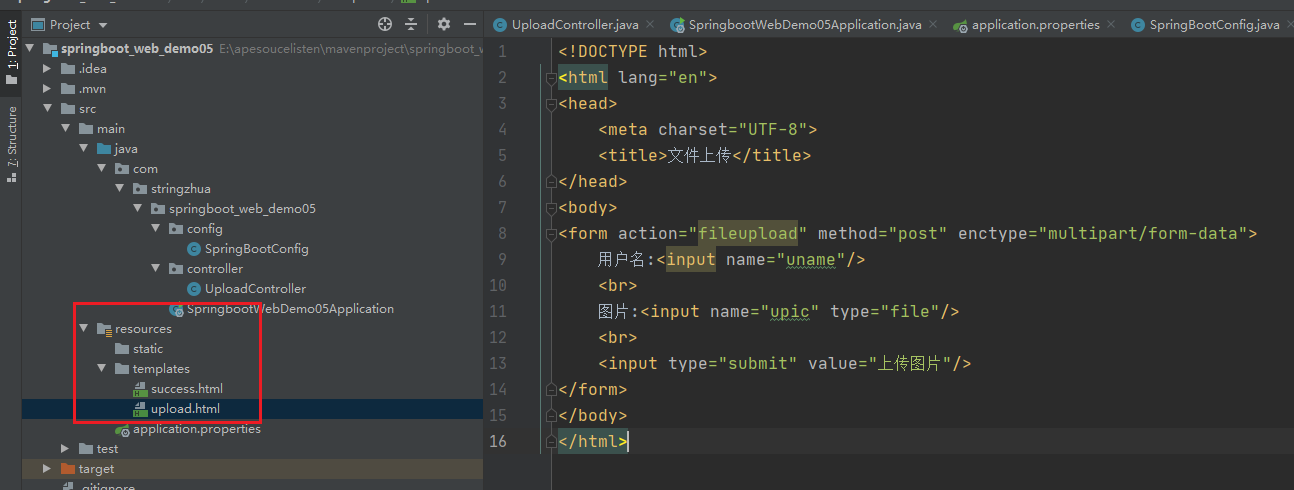
success.html
<!DOCTYPE html>
<html lang="en">
<head>
<meta charset="UTF-8">
<title>文件上传</title>
</head>
<body>
上传成功
<span>#(session.picname)</span>
<img src="http://sk1sw9rkd.hn-bkt.clouddn.com/#(session.picname)"/>
<form action="delete" method="post" enctype="multipart/form-data">
<button>删除</button>
</form>
</body>
</html>

upload.html
<!DOCTYPE html>
<html lang="en">
<head>
<meta charset="UTF-8">
<title>文件上传</title>
</head>
<body>
<form action="fileupload" method="post" enctype="multipart/form-data">
用户名:<input name="uname"/>
<br>
图片:<input name="upic" type="file"/>
<br>
<input type="submit" value="上传图片"/>
</form>
</body>
</html>

2.编写Controller层:
@Controller
public class OneController {
//进入测试页面
@RequestMapping("/show")
public String show(){
return "index";
}
//文件上传
@RequestMapping("/fileupload")
public String fileload(String uname, MultipartFile upic, HttpServletRequest request){
System.out.println("用户名"+uname);
System.out.println(upic);
System.out.println(upic.getOriginalFilename());
System.out.println(upic.getName());
return "success_File";
}
}
一般将文件upic以流的方式写入当前服务器磁盘(应用服务器)
这里我们使用文件服务器 七牛云
重新修改为七牛云的Controller:
package com.stringzhua.springboot_web_demo05.controller;
import com.google.gson.Gson;
import com.qiniu.common.QiniuException;
import com.qiniu.http.Response;
import com.qiniu.storage.BucketManager;
import com.qiniu.storage.Configuration;
import com.qiniu.storage.Region;
import com.qiniu.storage.UploadManager;
import com.qiniu.storage.model.DefaultPutRet;
import com.qiniu.util.Auth;
import org.springframework.stereotype.Controller;
import org.springframework.web.bind.annotation.RequestMapping;
import org.springframework.web.multipart.MultipartFile;
import javax.servlet.http.HttpServletRequest;
/**
* @Author Stringzhua
* @Date 2024/9/19 14:14
* description:
*/
@Controller
public class UploadController {
@RequestMapping("upload")
public String upload() {
return "upload";
}
//文件上传
@RequestMapping("/fileupload")
public String fileupload(String uname, MultipartFile upic, HttpServletRequest request) {
//获取文件信息
System.out.println("用户名" + uname);
System.out.println(upic);
System.out.println(upic.getOriginalFilename());
System.out.println(upic.getName());
//将文件保存到磁盘的某处
//方式1.将文件upic以流的方式写入当前服务器磁盘(应用服务器)
//方式2.文件服务器(七牛云)
//构造一个带指定 Region 对象的配置类
Configuration cfg = new Configuration(Region.autoRegion());
//...其他参数参考类注释
UploadManager uploadManager = new UploadManager(cfg);
//生成上传凭证,准备开始上传
String accessKey = "Farupk0sMM7VMjF3xluaFTjwUQ-DtwA1QW1LOvMH";
String secretKey = "kdzeXaRT8uiV2KZfX1YF89vTu11wDeT2fwGqGlBu";
String bucket = "stringzhuaworkspace";
//默认不指定key的情况下,以文件内容的hash值作为文件名
String key = null;
String name = null;
try {
byte[] uploadBytes = upic.getBytes();
Auth auth = Auth.create(accessKey, secretKey);
String upToken = auth.uploadToken(bucket);
try {
Response response = uploadManager.put(uploadBytes, key, upToken);
//解析上传成功的结果
DefaultPutRet putRet = new Gson().fromJson(response.bodyString(), DefaultPutRet.class);
System.out.println(putRet.key);//获取文件名
System.out.println(putRet.hash);//获取文件hash值
name = putRet.key;
} catch (QiniuException ex) {
Response r = ex.response;
System.err.println(r.toString());
try {
System.err.println(r.bodyString());
} catch (QiniuException ex2) {
//ignore
}
}
} catch (Exception ex) {
//ignore
}
request.getSession().setAttribute("picname", name);
return "success";
}
//删除文件
@RequestMapping("delete")
public String delete(String uname, MultipartFile upic, HttpServletRequest request) {
//构造一个带指定 Region 对象的配置类
Configuration cfg = new Configuration(Region.region0());
//...其他参数参考类注释
String accessKey = "Farupk0sMM7VMjF3xluaFTjwUQ-DtwA1QW1LOvMH";
String secretKey = "kdzeXaRT8uiV2KZfX1YF89vTu11wDeT2fwGqGlBu";
String bucket = "stringzhuaworkspace";
String key = (String) request.getSession().getAttribute("picname");
System.out.println(key);
Auth auth = Auth.create(accessKey, secretKey);
BucketManager bucketManager = new BucketManager(auth, cfg);
try {
bucketManager.delete(bucket, key);
} catch (QiniuException ex) {
//如果遇到异常,说明删除失败
System.err.println(ex.code());
System.err.println(ex.response.toString());
}
return "upload";
}
}
需要上传自己的密钥 并且新建一个存储空间
注意设置为公开 否则上传失败:

导入七牛云需要的坐标:
<!-- 七牛云文件上传需要的坐标-->
<dependency>
<groupId>com.qiniu</groupId>
<artifactId>qiniu-java-sdk</artifactId>
<version>7.2.25</version>
</dependency>
<dependency>
<groupId>com.squareup.okhttp3</groupId>
<artifactId>okhttp</artifactId>
<version>3.14.2</version>
<scope>compile</scope>
</dependency>
<dependency>
<groupId>com.google.code.gson</groupId>
<artifactId>gson</artifactId>
<version>2.8.5</version>
<scope>compile</scope>
</dependency>
<dependency>
<groupId>com.qiniu</groupId>
<artifactId>happy-dns-java</artifactId>
<version>0.1.6</version>
<scope>test</scope>
</dependency>
启动项目,测试上传:
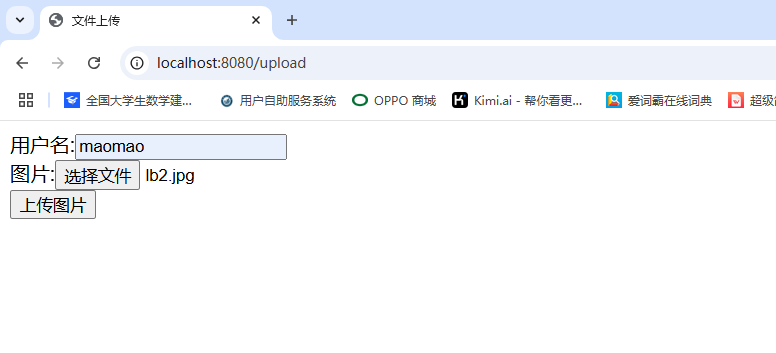
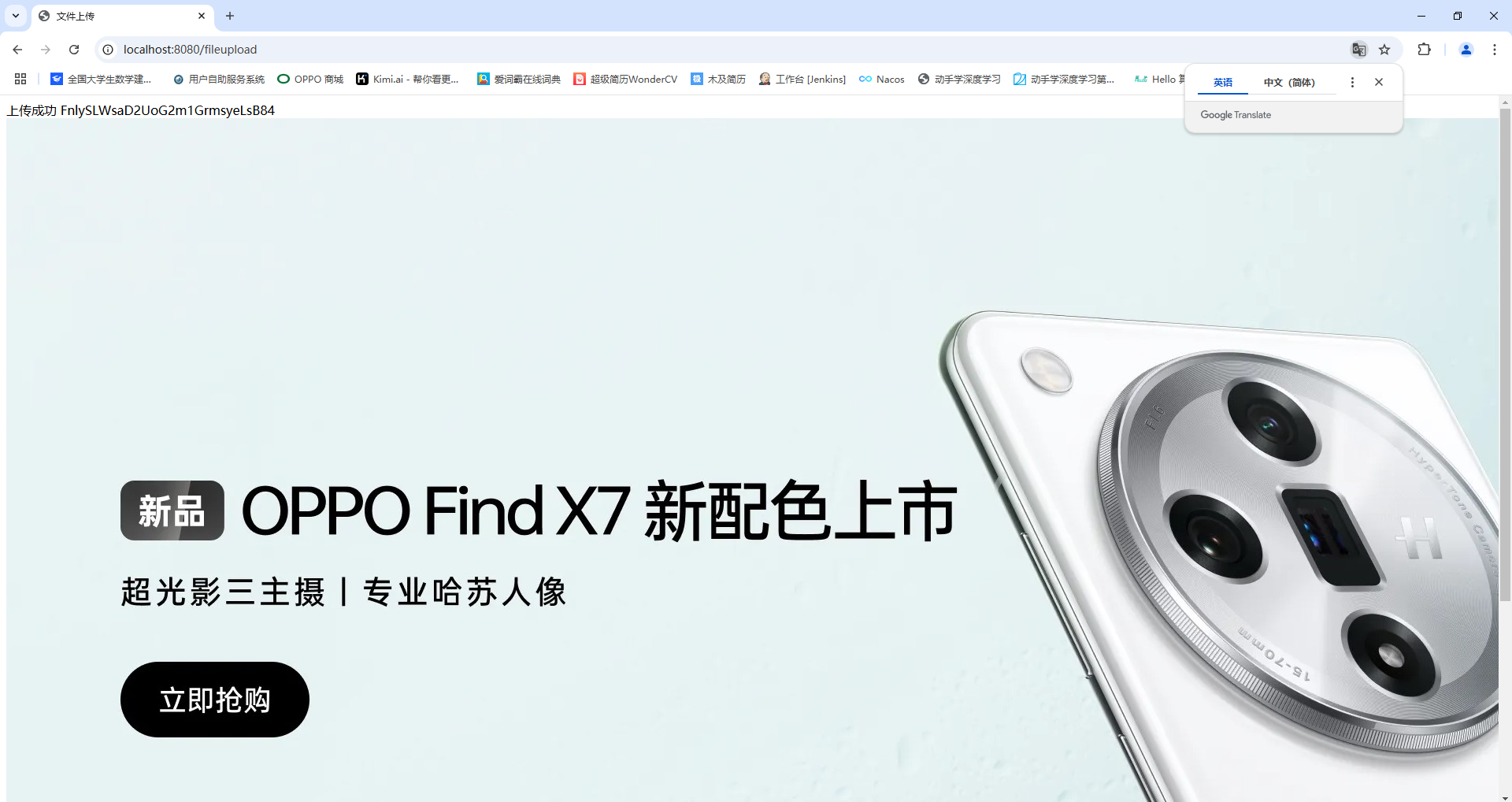

上传成功!

点击删除按钮,删除七牛云上的图片:
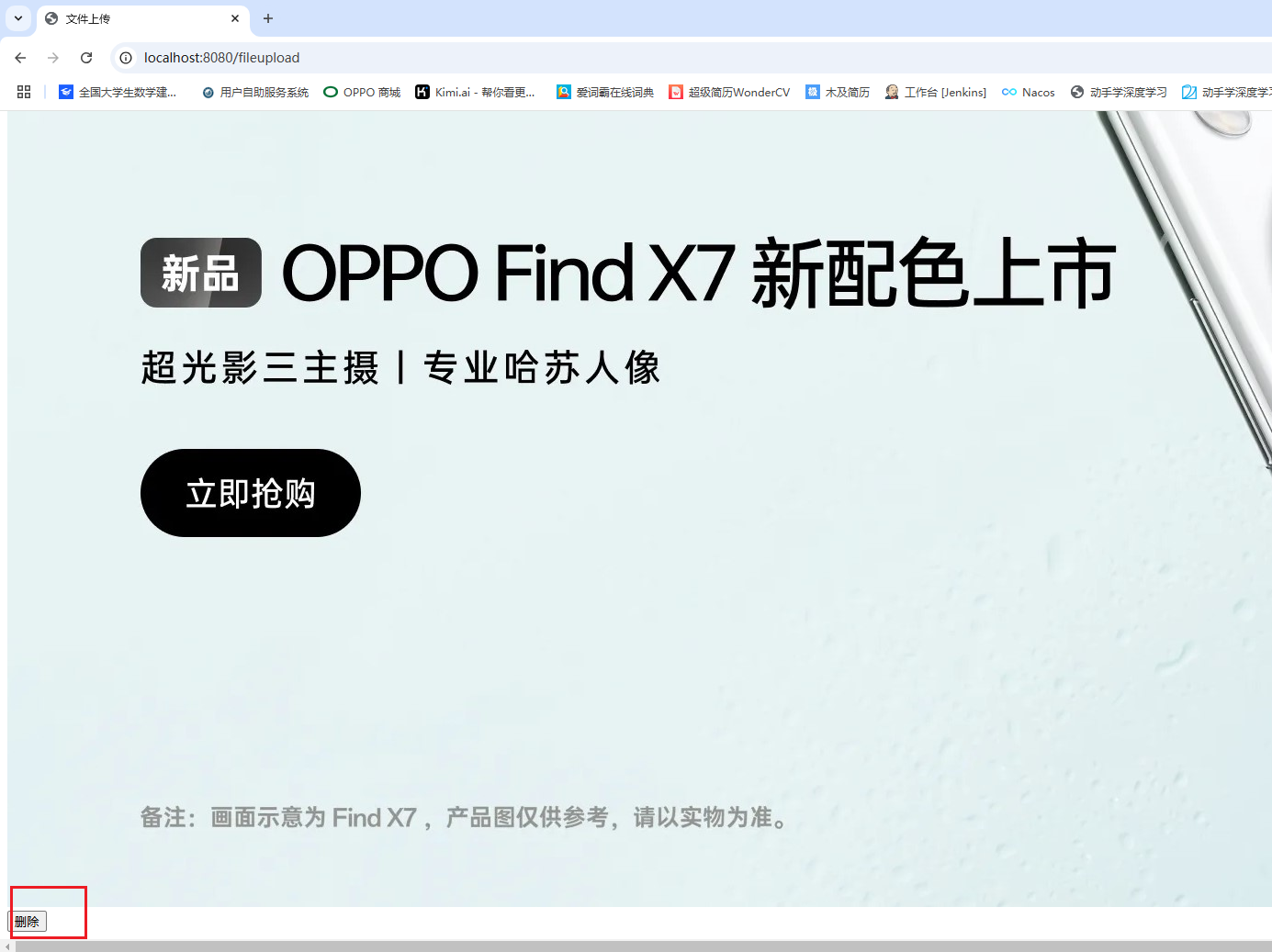


删除成功!
其他的详细操作,请查阅七牛云文档!
https://developer.qiniu.com/kodo/1650/chunked-upload
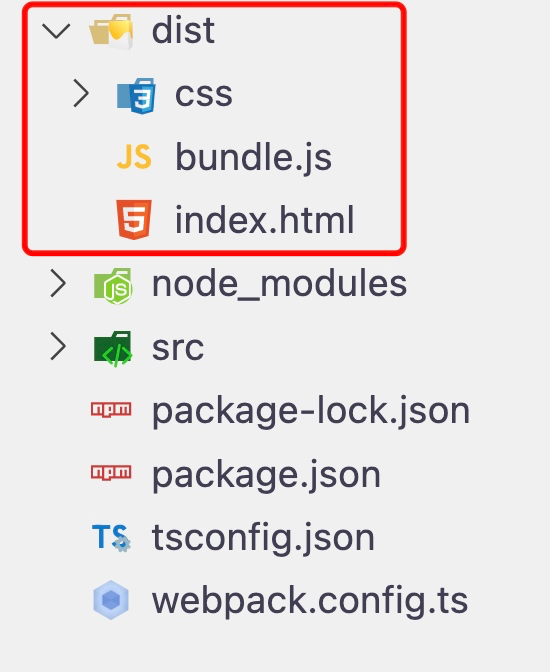













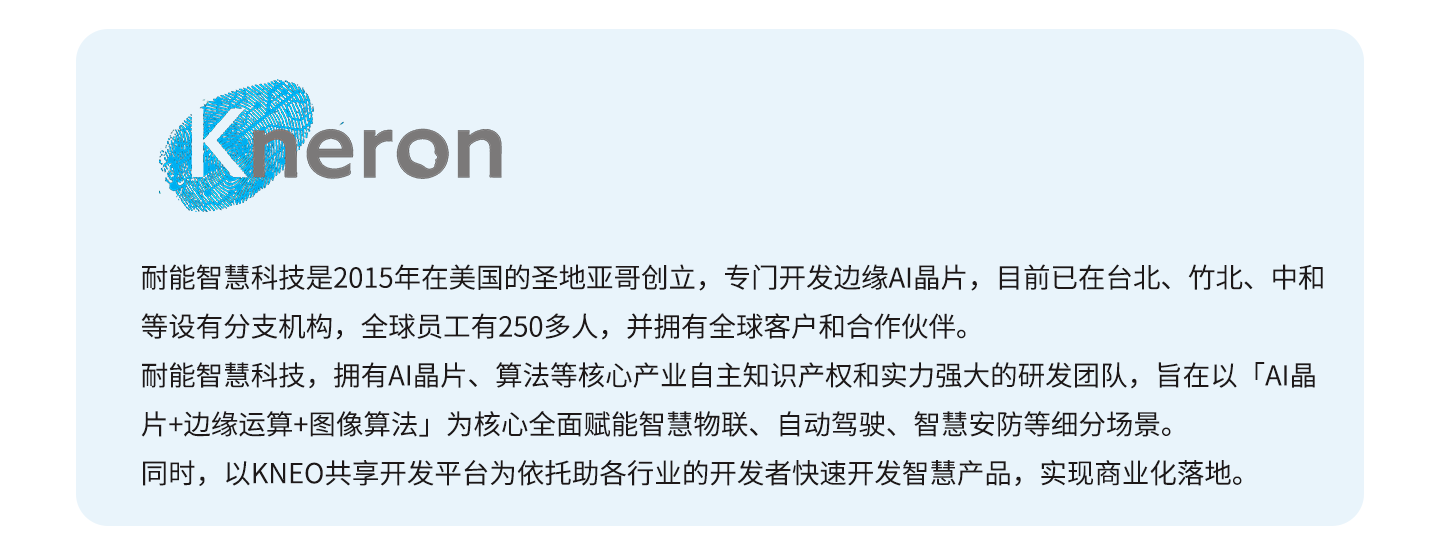
![[VUE]框架网页开发1 本地开发环境安装](https://i-blog.csdnimg.cn/direct/db8d3ea91d464fc7acbeed1b550d2365.png)



